U.S. FORECAST



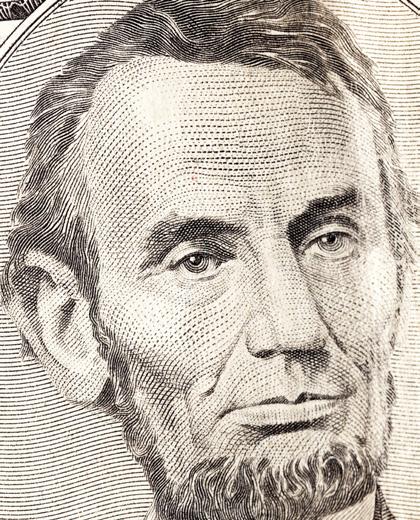
SPRING 2023
About University of Central Florida (UCF)
The University of Central Florida is a public, multi-campus, metropolitan research university, dedicated to serving its surrounding communities with their diverse and expanding populations, technological corridors, and international partners. The mission of the university is to offer highquality undergraduate and graduate education, student development, and continuing education; to conduct research and creative activities; to provide services that enhance the intellectual, cultural, environmental, and economic development of the metropolitan region; to address national and international issues in key areas; to establish UCF as a major presence; and to contribute to the global community.
About the College of Business
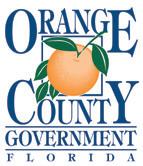
The College of Business advances the university’s mission and goal in providing intellectual leadership through research, teaching, and service. The college is striving to enhance graduate programs, while maintaining the strong undergraduate base. The college delivers research and quality business education programs at the undergraduate, masters, doctoral, and executive levels to citizens of the state of Florida and to select clientele nationally and internationally.

We would like to recognize the following organizations for their support of the Institute for Economic Forecasting:

U.S. FORECAST 2023 - 2027
Published quarterly by the Institute for Economic Forecasting, College of Business, University of Central Florida
Copyright © 2023 Institute for Economic Forecasting. All rights reserved.
Publications of the Institute for Economic Forecasting are made possible by the following staff:
Dr. Sean Snaith, Director
Noah Aguirre Researcher
Evan Aldrich, Researcher
Nefertari Elshiekh, Researcher
Al-Sadh Imadh, Researcher
Jake Nair, Researcher
Benjamin Snider, Researcher
Roman Syed, Researcher
Andrew Tritch, Researcher
This forecast was prepared based upon assumptions reflecting the Institute for Economic Forecasting judgments as of the date it bears. Actual results could vary materially from the forecast. Neither the Institute for Economic Forecasting nor the University of Central Florida shall be held responsible as a consequence of any such variance. Unless approved by the Institute for Economic Forecasting, the publication or distribution of this forecast and the preparation, publication or distribution of any excerpts from this forecast are prohibited.
IN THIS U.S. FORECAST
• The Pasta Bowl Recession hit the U.S. economy in the first half of 2022. There looks to be another serving on the menu for 2023.
• Unprecedented declines in labor productivity combined with high levels of price inflation allowed firms to continue to hire even as the output of the U.S. economy contracted in the first half of 2022.
• Payroll job growth of 4.3% in 2022 will decelerate in 2023, falling to 0.6%, and further to -1.8% in 2024 and -0.5% in 2025 before turning slightly positive at 0.4% in 2026.
• U.S. consumers provided the muscle that powered the 2020 recovery. Following the end of most lockdowns, consumers were ready to spend. Since then, high energy prices, food costs, and housing costs have steadily eroded their purchasing power. While credit card debt has temporarily patched the hole in their monthly budgets, this loss has set the table for the next serving of the Pasta Bowl Recession.
• Real consumption spending accelerated to 8.3% in 2021, then eased to 2.8% in 2022 due to falling real wages. Spending will decelerate to 0.9% in 2023 and then to 0.5% in 2024 before rising to 1.2% in 2025 and 2.2% in 2026.
• The Federal Reserve cut interest rates to near-zero in the face of a COVID-19 policy induced recession, and the Fed’s balance sheet has grown to $8.9 trillion. The Fed has been playing catch-up after it shifted into inflation-fighting mode. The failure of Silicon Valley Bank should not distract the Fed from its dual objectives.
• Real GDP growth was -2.8% in 2020 but accelerated to 5.9% in 2021. It eased to 2.1% in 2022, it will further slow to 0.4% in 2023, and will slowly rise to 0.8% in 2024. Then, real GDP growth will approach 1.3% in 2025, and 1.8% in 2026.
• The housing market remains tight. High prices plus rising mortgage rates have eroded demand. However, still-low inventories will underpin the sector. Housing starts will decline from 1.6 million in 2022 to 1.1 million in 2023 and 2024, before rising to nearly 1.3 million in 2026.
• 10.8 million job openings will provide a shock absorber for the impact of the Second Pasta Bowl Recession on the labor market. The headline unemployment rate (U-3) is expected to rise from 3.6% in 2022 to 6.3% early in 2025 before beginning a gradual decline later that year.
• Consumer price inflation will continue a slow decline in the latter half of 2023 as energy and food prices have slowed the pace of this decline. By the end of 2024, inflation will be close to the Fed’s target level of 2% thanks to interest rate hikes and the Second Pasta Bowl Recession.
HIGHLIGHTS
SPRING 2023
We’ve Had Jobless Recoveries, Why Not a Jobfull Recession? The Pasta Bowl Recession and the Labor Market
As the U.S. economy emerged from the 1990-91 recession, a new term entered the economic lexicon: a jobless recovery. The economy had come out of that recession in March of 1991, but job growth remained very weak. It took nearly two years of economic recovery to get back to the level of employment the economy had reached prior to entering that recession. A similar situation arose after the 2001 recession ended. In that recovery, it took more than two years to get back to pre-recession levels of employment. Both of these recoveries were deemed “jobless recoveries;” the economy was growing again, but businesses were slow to hire workers.
Most of the subsequent research into why these two recoveries were “jobless” pointed to the role of the productivity of labor in dampening the need for businesses to hire more workers even as their output was ramping up.
Technology was cited in each of these instances of jobless recoveries as being the reason why hiring was slow to accelerate. In the early nineties, the use of personal computers had become widespread in the economy and the impact on labor productivity was noticeable. In the two years that followed the 90-91 recession, the average quarterly level of productivity growth was four times faster than during the two years that preceded that recession.
In the recovery that followed the 2001 recession, there were also several quarters where productivity took sizeable leaps. During 2003, the average quarterly productivity growth was 5.6%, and the average annual productivity growth in 2002 and 2003 was the fastest since 1993, during the previous jobless recovery. The ubiquity of personal computers was further enhanced by the connectivity afforded
via advances in internet technology allowing workers to be more productive and thus reducing the need to hire as this recovery played itself out.
This brings us to 2022. In the first two quarters of last year, real GDP contracted by 1.6% and 0.6%. While not the definition of a recession, it is a useful rule of thumb in that since 1946 (the last time the economy contracted for two consecutive quarters and a recession was not declared), every time the economy contracted for two consecutive quarters, a recession was subsequently declared.
In our Spring 2022 U.S. Forecast, we declared that the U.S. economy was in, or on the brink of, a pastabowl-shaped-recession. A little more than a month after that forecast was made, the announcement was made that the U.S. economy had contracted in the 2nd quarter of 2022, making it two consecutive quarters of negative growth. By the two-consecutivequarter GDP contraction rule-of-thumb, we were in fact in the predicted pasta bowl recession.
This sparked much debate at the time, some of it politically motivated, that, no, there was not a recession in the first half of 2022. Most of the contrarian views on the recession pointed to the labor market as the reason why the U.S. couldn’t be in a recession.
During the first six months of 2022, businesses added an average of 445 thousand employees to their payrolls each month during the first and second quarters of that year. “An economy that is in a recession doesn’t generate that level of hiring,” was the gist of the contrarian view on whether there was a recession in the first half of 2022.
However, there was something else going on
U.S. F ORECAST Institute for Economic Forecasting 5
in the labor market during the first half of 2022. Specifically, labor productivity in those two quarters contracted at the fastest two consecutive quarterly rates in the history of that data series. Labor productivity contracted by 6.1% in the first quarter followed by a 3.8% contraction in the second quarter.
Now textbooks tell us that a fall in labor productivity, other things equal, should lead to a decline in the demand for labor. The payroll jobs numbers for the first half of 2022 clearly show that didn’t happen. However, other things were not equal. High rates of price inflation had already taken root in the economy starting in the 2nd quarter of 2021 and continuing through the first half of 2022. In the second quarter of 2022, annual CPI inflation hit 9.7% and PPI inflation hit 20.3% that same quarter.
These levels of inflation change hiring decisions significantly. The larger problem of the firm is to maximize profits. In the context of hiring, this means a firm will continue to add workers if the market value of what the worker produces meets or exceeds what it costs to hire that person.
If a worker brings in more revenue to the firm than the firm must pay that worker, the firm’s total profits will rise because of that hire. If a worker costs the firm more than they bring in revenue, the firm’s total profits will decline, and that worker should not be hired.
So even though the number of goods and services that each worker was producing was declining (and real GDP along with it) in the first half of 2022, the price at which those goods and services sold was rising much faster (and much faster than wages), so firms continued to hire workers and enjoyed rising profits even as the overall economy contracted. Thus, these conditions gave rise to a pasta-bowl-shaped “jobfull recession.”
A separate, but related, question is: what led to the historic contraction of labor productivity?
The jobless recoveries were attributed to technology-driven increases in worker productivity. Technology couldn’t be responsible for a loss of productivity, could it?
If you build a better mousetrap, then a pest control
technician is going to catch more mice, making them more productive. Were we ensnared in a technological mousetrap of our own creation that resulted in the falling productivity in the first half of 2022?
I think subsequent analyses of that period in our economic history will have to consider the widespread adoption of work-from-home and the negative impact it may have on worker productivity. Many firms were forced to adapt to this business model, and most were probably not set up in terms of monitoring employee activity under these working conditions.
Workers able to taste this forbidden fruit, some for the first time, very likely could have been less productive than they had been in an office or workplace setting. But because of rising prices and profits, firms continued to hire.
ANXIOUS INDEX Fear of Recession Still at a Level Historically Consistent with a Recession
The most recent release (1st quarter of 2023) of the Survey of Professional Forecasters by the Federal Reserve Bank of Philadelphia states that the forecasters surveyed for the publication put a 42.41% chance that a decline in real GDP will occur in the 2nd quarter of 2023.
One section of the Survey of Professional Forecasters asked panelists to estimate the probability that real GDP will decline in the quarter in which the survey is taken, as well as the probabilities of a decline in each of the following four quarters. The anxious index is the estimated probability of a decline in real GDP in the quarter after a survey is taken. In the survey taken in January for the 1st quarter of 2023, the index stands at 42.41, meaning forecasters believe there is a 42.41% chance that real GDP will decline in the 2nd quarter of 2023. This is down slightly from 47.17% in the survey taken in the 4th quarter of 2022. However, this level for the anxious index is still historically consistent with the level that prevailed during previous recessions in the U.S.
U.S. F ORECAST 6 U.S. Forecast / Spring 2023
The Figure 1 plots the historical values of the anxious index, where the gray bars indicate periods of recession in the U.S. economy. The current level of the anxious index is more than 24 points higher than the average level during the previous economic recovery (17.99).
GDP OUTLOOK Pasta Bowl Recession, A Second Serving in 2023
The National Bureau for Economic Research (NBER) declared on June 8, 2020, that the longest economic expansion in U.S. history enjoyed its final month in February 2020. This declaration meant that as of March, the U.S. economy was in recession. On July 19, 2021, the NBER declared that the recession had ended in April of 2020. This announcement meant that the deepest recession since the Great Depression was also the shortest recession in U.S. economic history (6 months was the previous record for the shortest recession.). It also confirmed that the economic lockdowns were the drivers of this horrible economic cycle.
Fiscal and monetary policy were unleashed in a historic manner to counter the toxic effect of the
public health measures on the U.S. economy. While the combined policy effects were clearly not enough to offset the damage the lockdowns have done, they lessened the severity of the historic recession. The overreliance on fiscal stimulus as the recovery progressed at a more than robust pace turned out to be overkill, but multi-trillion-dollar deficits fueled a spending frenzy that continued for more than two years after the recession ended. That spending was the spark that ignited inflation and ultimately sowed the seeds of the Pasta Bowl Recessions— yes plural.
As discussed above, I feel that in the first half of 2022, the U.S. economy experienced its first of two pasta bowl shaped recessions. I think that the second pasta bowl recession will arrive this year. I don’t think this will turn into an economic version of Olive Garden’s never-ending pasta bowl, but many indicators suggest that we are on the brink of or currently in another relatively short and shallow recession.
While the labor market showed little signs of the 2022 recession, the second pasta bowl recession will not be as innocuous when it comes to the labor market. I think we will see unemployment rising as 2023 progresses and this will continue into 2024 and into 2025. Job growth will turn negative but not as sharply as was the case in the wake of the 2008-09 and 2020 recessions.
The reality of recessions in the U.S. is that they are determined based on the judgment of a small cabal of economists, who may or may not be influenced by political cycles. There is no litmus test that can objectively determine when recessions start and end. The unusual nature of the economic cycles driven by COVID-19 policies will make the determination of recession a more complicated proposition.
U.S. F ORECAST Institute for Economic Forecasting 7
Figure 1.
0 10 20 30 40 50 60 70 80 90 100 1968 1969 1970 1971 1972 1973 1974 1975 1976 1977 1978 1979 1980 1981 1982 1983 1984 1985 1986 1987 1988 1989 1990 1991 1992 1993 1994 1995 1996 1997 1998 1999 2000 2001 2002 2003 2004 2005 2006 2007 2008 2009 2010 2011 2012 2013 2014 2015 2016 2017 2018 2019 2020 2021 2022 2023 Probability (percent) Quarter for Decline
Source: Survey of Professional Forecasters, Philadelphia Federal Reserve Bank
The Anxious Index One-Quarter-Ahead Probability of Decline in Real GDP Quarterly, 1969:Q1 to 2023:Q2
The shading shows the period beginning with each NBER peak and ending with the corresponding trough.
CONSUMER SPENDING
High Electricity, Food, and Housing Prices Continue to Hurt Consumers
U.S. consumers have been hit hard by high inflation. Even though wage and salary growth is the strongest it has been in years, the cost of living has eroded all of those wage gains and then some. Since the second quarter of 2021, real median weekly wage and salary growth has been negative. This means that even though workers have more dollars in their paychecks, the amount of goods and services that they can purchase with these dollars has been declining for nearly two years.
The headline rate of CPI inflation understates the impact that inflation is having on households because the biggest expenditures households make are for food, shelter, and transportation—all of which have had inflation rates much higher than the overall CPI.
The U.S. consumer and the U.S. economy were devastated by the lockdowns and closures, a consequence of public health restrictions. As a result, real consumer spending plummeted in the second quarter of 2020 at an annual rate of 32.1%. This followed a smaller decline in spending of 6.2% in the 1st quarter as public health restrictions were first rolled out in March of 2020.
In the 3rd quarter, pent-up demand from consumers who were also cooped-up in their homes was unleashed, leading to an annualized 43.0% growth in consumer spending for the quarter. In the 4th quarter of 2020, consumer spending grew more modestly at 3.9%. In the 1st quarter of 2021, consumers were again spending robustly, fueled by federal stimulus payments, and consumption spending soared again to a 10.8% rate of growth at an annual rate and maintained this pace in the 2nd quarter as spending grew 12.1%. As the rest of the COVID-19 pent-up demand was released, growth remained strong for the full year of 2021 at 8.3%.
The CARES Act and subsequent stimulus payments plus supplemental unemployment insurance payments helped to ease some of the pain consumers felt from the public health lockdowns. In addition to these programs, increases in the child tax credit that are payable in advance put additional
disposable income into the consumers’ pockets which continued to fuel spending growth through 2021.
The Uncle Sam giveaway to consumers has ended. Inflation is hitting households hard. 62.8% of consumer expenditures go to food, shelter, and transportation; and all three categories have seen outsized price increases over the past 20 months. Consumer confidence is at a 40-year low as of August. Consumer spending is nearly 69% of GDP and the erosion of confidence is a key reason the economy is experiencing the Pasta Bowl Recession.
In 2019, consumer spending growth decelerated to 2.2% from 2.9% in 2018. The public health policies aimed at slowing the spread of COVID-19 caused spending growth in 2020 to contract by 3.0%.
Consumption spending growth slowed from 8.3% in 2021 to 2.8% in 2022. During 2023-2026, consumer spending growth is expected to average 1.2%.
Consumer spending growth will be dampened by recession to 0.9% in 2023 and 0.5% in 2024 before accelerating in the next two years to 1.2% and 2.2% in 2026.
INVESTMENT
The COVID-19 recession and the presidential election in 2020 created an atmosphere of high uncertainty in the economy. Uncertainty is the enemy of investment spending, and business pullbacks on investment reflected this uncertainty.
Nonresidential fixed investment spending eased in 2019 to 3.6% from 6.5% in 2018. In 2020, investment spending contracted by 4.9%.
Spending on equipment and software turned negative in 2020 and contracted by 10.5%. In 2021, spending grew 10.3% an outsized 20.8 percentage point swing. Average growth in this type of investment spending is expected to be -1.3% over the 2023-2026 timeframe, with the recession weighing on these expenditures through 2025, but most heavily in 2023 and 2024.
Investment in aircraft is historically volatile and a single aircraft order from a major airline can move this figure by tens of billions of dollars. The problems Boeing faced with its 737 Max planes weighed heavily in 2018-19. This caused a sharp reversal
U.S. F ORECAST 8 U.S. Forecast / Spring 2023
of growth in 2019 to -41.6%. 2020 made matters initially and temporarily worse for the industry as air travel collapsed globally when the COVID-19 pandemic spread. But as things reopened in 2020, investment surged by 34.5%. That was followed by another sharp increase in 2021 as investment surged 29.0%.
This rebound in 2021 decelerated in 2022 as airlines faced labor shortages, there is no point in buying more aircraft if you don’t have the pilots to fly them. However, aircraft purchases still grew by 16.2% that year. Over the next four years, spending on aircraft is expected to grow an average of 1.0%, with growth hitting 10.8% in 2023 as the economy emerges from another recession and airline staffing rebounds. Quarter-to-quarter and even year-overyear volatility in this type of investment spending is the rule, particularly in this COVID-impacted and supply-chain-challenged economic environment.
The 2016 slowdown in overall investment spending also reflected the negative impact of oil prices falling by nearly two-thirds. Consumers enjoyed the low prices at the gasoline pump, but oil producers—shale and otherwise—cut back on investments as oil prices dropped below $40 per barrel early in 2016. The rig count in the U.S. hit a seventy-year low of 404 in response to plunging oil prices. In the middle of the COVID recession, an oil price war broke out and drove spot prices to one point below zero. This price drop caused the U.S. rig count to further plummet to 282. Higher oil prices due in part to the strong economic recovery and the stoppage of the construction of the Keystone XL pipeline have pushed the current rig count to 758 which is 88 higher than a year ago. The Russian invasion of Ukraine temporarily pushed oil prices to record highs, and this historically would continue to drive the rig counts even higher, though the response has been muted under Biden administration policies.
In recent months, recession and previous record prices have caused demand to shrink, and as a result, the price of oil has fallen substantially into the low $70s. This will dampen investment spending in the near term.
During 2015 and 2016, investment in mining and petroleum equipment contracted by 28.6% and
41.8%, respectively. In 2017, growth hit 40.4% and came in at 27.8% for 2018, before declining by 0.3% in 2019 and plunging to 38.4% in 2020. Investment will average a 3.0% growth per year during 20232026 after growing 15.3% in 2022 and 7.2% in 2023. It will be hindered by the impacts of the green energy initiatives of the Biden administration and by falling prices in 2024-25, when we expect investment spending to contract by an average of 1.1%.
Business nonresidential structures investment growth hit 4.4% in 2017 and decelerated to 4.1% in 2018. Spending growth further decelerated to 2.3% in 2019 before contracting by 10.1% in 2020 and again by 6.4% in 2021. Nonresidential spending will continue to contract at an average rate of 2.7% during the four years of our forecast horizon.
Interest rates plummeted during the pandemic. The Federal Reserve cut short-term interest rates to near zero and kept them there for nearly two years. The interest rates on U.S. Treasury bonds fell to historic lows but have since risen significantly. Rising interest rates are not good for investment, but since the Fed has now switched gears to go into an aggressive inflation-fighting mode, this will be an increasing headwind for business investment spending.
Business spending on industrial equipment will grow at an annual average rate of -0.4% from 20232026. Investment spending growth on computers and peripherals will average 2.7% during 2023-2026. Spending on communications equipment should expand at an average annual rate of 4.2% during the same four-year span, with spending in 2023 expanding at an 11.0% rate with the ongoing rollout of 5G mobile internet technology.
Residential fixed investment growth hit 7.2% in 2020, before rising to 10.7% in 2021. Growth will average -0.9% during 2023-2026, as higher prices combined with rising mortgage rates erode demand and cause investment spending to contract 10.7% in 2022 and 18.0% in 2023.
We expect housing starts to decelerate in 2023 but continue to be steady over the following year before accelerating. After reaching nearly 1.6 million in 2021, starts will fall to 1.1 million before accelerating to a level slightly below 1.30 million in 2026. Rising mortgage rates and high home prices are headwinds,
U.S. F ORECAST Institute for Economic Forecasting 9
as is the Pasta Bowl Recession, and all three will continue to shape the residential sector for the next two years. The ongoing shortage of housing that is plaguing the sector in many parts of the country will push starts higher in 2025 and 2026.
GOVERNMENT SPENDING
Government budget management has become a series of continuing resolutions, a series of COVID-19 stimulus packages, and spending made under the umbrella of a pandemic emergency declaration. This spending is devoid of any policy discussions or debates about priorities, problems, or objectives. Unsurprisingly, our public finances are adrift, and deficits climbed back to the $1 trillion mark even before the torrent of spending from the pandemic. This was all before public health measures plunged the economy into the deepest recession since the Great Depression, worsening the fiscal outlook. Federal government spending growth was just 0.4% in 2017. In 2018, it expanded by 3.0%, and in 2019, it rose again by 3.9% before jumping to 6.2% in 2020. During the 2023-2026 period, federal government spending growth is going to be slightly negative, growing at an annual average pace of 0.9%, mostly attributable to the temporary pause in spending growth in 2024. Over the same time frame, state and local governments will see spending growth at an average rate of 1.0%. This modest growth in spending will be the smallest in 2024 before growth returns in the final years of our forecast.
We are projecting deficits through 2026 that will consistently average more than $1.8 trillion. The amount that the projected deficits will add to the national debt over the next four years will be more than $7.3 trillion, pushing the total national debt to nearly $39 trillion and a debt-to-GDP ratio of 132%. As interest rates in the economy continue to rise, the burden of servicing this debt will rise as well. Spending by the Biden administration (and Congress) will help push this debt to even higher levels than we are currently projecting if interest rates rise more quickly than anticipated. Slowerthan-projected economic growth or a recession deeper than the Pasta Bowl would also push projected deficits higher, though the possibility of
faster-than-projected economic growth would help mitigate the growth of these deficits.
Currently, the national debt is over $31.6 trillion and rising. This represents a debt of nearly $246,868 per taxpayer and $94,548 per citizen. The unfunded liabilities of the U.S. are even more disturbing. These include Social Security, Medicare parts A, B, and D, and Federal debt held by the public and federal employee and veteran benefits, representing more than $182.4 trillion in liabilities, boiling down to more than $544,955 per citizen.1
NET EXPORTS
COVID-19 inflicted havoc on the global economy. International trade crumbled in the 2nd quarter of 2020. Real exports collapsed by 60.9% at an annual rate, while real imports plunged by 53.7%. But like the rest of the economy, the external sector came rushing back in the 3rd quarter of 2020. Real exports grew at an annual rate of 59.5% that quarter, with real imports growing at an 88.2% pace as consumer spending was reignited.
The U.S. dollar appreciated for five straight years against our major trading partners, including an outsized 15.8% appreciation in 2015. In 2016, this trend moderated; in 2017 and 2018, the dollar returned some of these gains. However, after the Fed raised interest rates and the U.S. economy experienced faster growth relative to our trading partners, the dollar appreciated again in 2019 at a 3.5% pace before depreciating 1.1% in pandemicaddled 2020.
Beginning in the second half of 2021, the dollar began a significant appreciation that continued through the third quarter of 2022 and included a very large 21% appreciation in the second quarter of 2022, followed by another jump of 20% in the third quarter.
A stronger dollar boosts imports and reduces exports by making our goods and services more expensive to foreigners while at the same time making imported goods and services less expensive to U.S. consumers. This results in a worsening of
U.S. F ORECAST 10 U.S. Forecast / Spring 2023
1 National debt data from: http://www.usdebtclock.org/
the trade deficit, which is the difference between the dollar value of exports and the dollar value of imports.
However, the effects of currency changes take time to work on the actual quantity of trade flows, resulting in what is known as the J-curve effect on net exports. Because of this effect, an appreciation of the dollar initially decreases the trade deficit before eventually increasing it. Why? Importers and exporters do not enter contracts based on the total dollar value of the transaction, but rather the actual quantity of goods to be shipped (automobiles, flatscreen televisions, etc.). As the exchange rate varies in the short run, the values of these shipments and, thus, net exports vary as well. Over time, however, the quantities do adjust in response to the exchangerate fluctuations, and this is what gives rise to the J-curve effect.
The Russia-Ukraine war, the ensuing sanctions, and rise in uncertainty will impact global trade, but Russia is a minor trading partner with the US and the direct effects of any restriction in trade have been relatively small. This is not the case for Europe.
Overall, real export growth has resumed, after a sharp contraction in 2020, and will continue through the end of our forecast horizon after accelerating sharply in 2021 and 2022. The recent appreciation of the dollar will cause a deceleration of this growth in 2023 and 2024. Real import growth also experienced a strong contraction in 2020, but growth recovered and will continue through 2025. The Pasta Bowl Recession will cause import growth to decelerate sharply in 2023. Trade issues, recession, war, and COVID-19 notwithstanding, real export growth from 2023-2026 will average 4.0%, while real import growth will average 1.1% over the same time frame.
Real net exports will average over -$1.1 trillion during 2023-2026, with the trade balance slowly declining over most of that period, before ticking up to -$1.12 trillion in 2026.
UNEMPLOYMENT
The national headline unemployment rate (U-3) in February 2023 stood at 3.6%: down 11.2 percentage points from the April 2020 reading of 14.8%, which
was the highest level since the Great Depression era . The labor force participation rate rose in February 2023 to 62.5% from the February 2022 rate of 62.2%.
The February jobs report exceeded expectations as growth in payroll jobs hit 311,000 when the expected growth of this figure had been 205,000. The 24,920,000 jobs increase in payroll employment since April 2020 comes after 21,991,000 payroll jobs were lost in March and April. Payrolls have surpassed February 2020 levels, recovering all the jobs lost from a historic and self-inflicted recession.
The Bureau of Labor Statistics (BLS) produces alternative measures of labor market weakness, including the broadest measure of unemployment (U-6). U-6 accounts for discouraged workers (currently 363,000 workers), underemployed workers—working part-time but not by choice— (currently 4.07 million workers), and workers who are marginally attached to the labor force—those who have looked for work in the past 12 months, but are not currently looking, yet indicate a willingness to work (1.4 million workers). None of these 5.7 million-plus workers are accounted for in the February headline unemployment rate of 3.6%.
U-6 stands at 6.8% as of February 2023, down 6.0 points from the September 2020 level, and down 0.3 percentage points from the start of 2022. The current level of U-6 is on par with its 6.8% level in December 2019. U-6 was stuck in double digits for more than seven years. It had been in single digits for fifty-one consecutive months, beginning in December 2015 before surging during the lockdowns in April and May.
The spread between U-6 and U-3 measures of unemployment has stayed at 3.2 percentage points and is 4.2 points below the peak spread of 7.4 points that took place in September of 2011.
U.S. F ORECAST Institute for Economic Forecasting 11
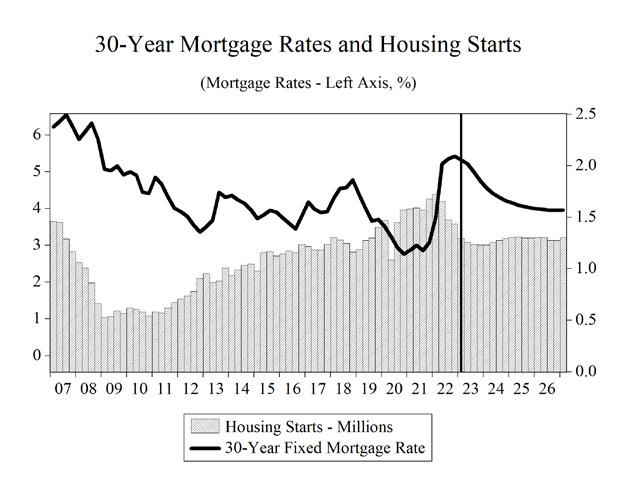


Ch ARTS 12 U.S. Forecast / Spring 2023
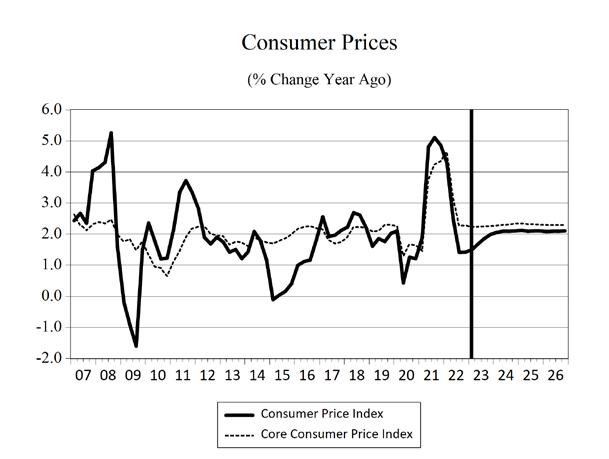

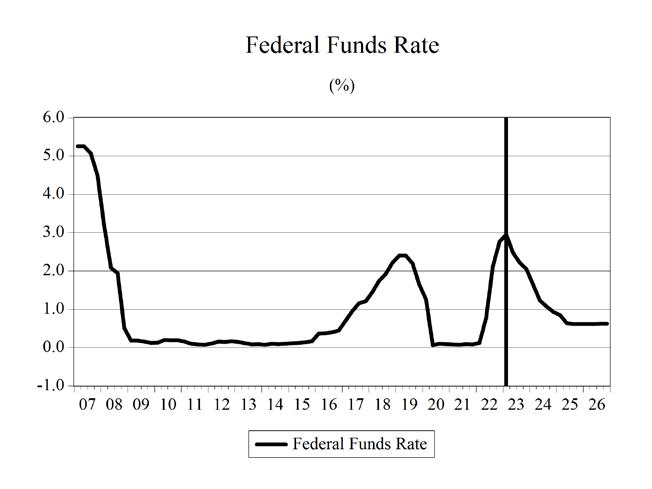
Ch ARTS Institute for Economic Forecasting 13
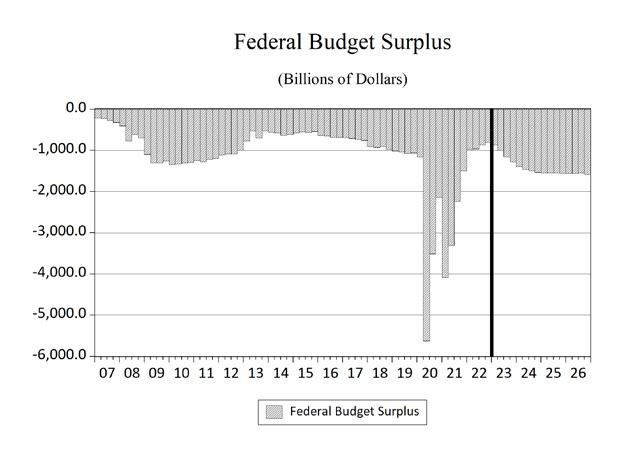
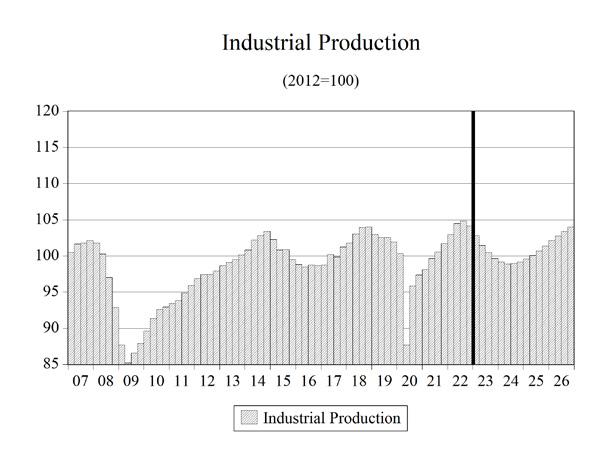

Ch ARTS 14 U.S. Forecast / Spring 2023
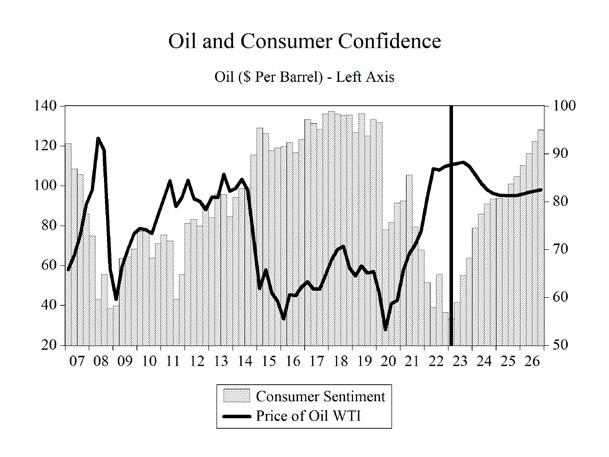
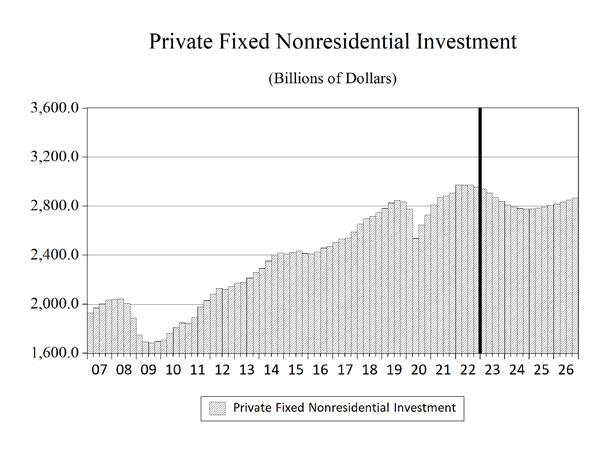
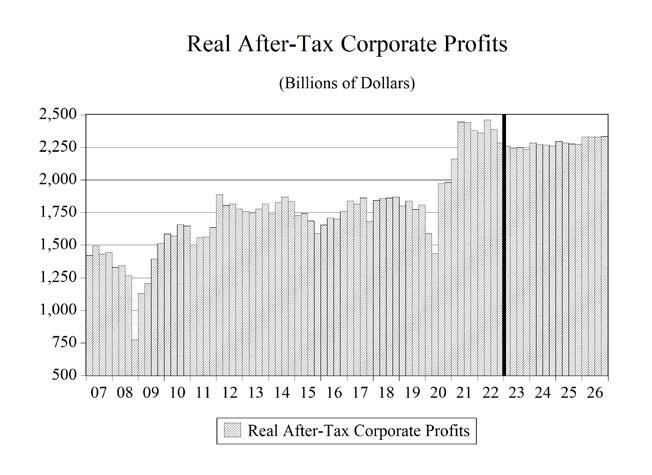
Ch ARTS Institute for Economic Forecasting 15
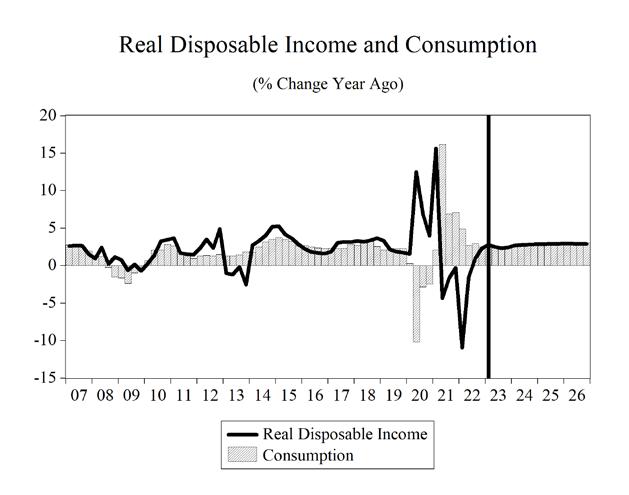


Ch ARTS 16 U.S. Forecast / Spring 2023
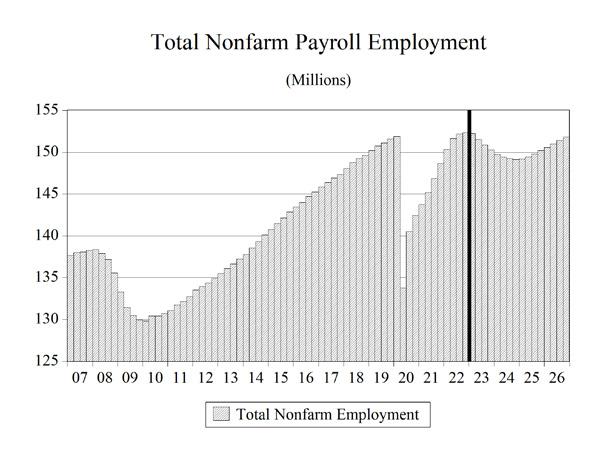

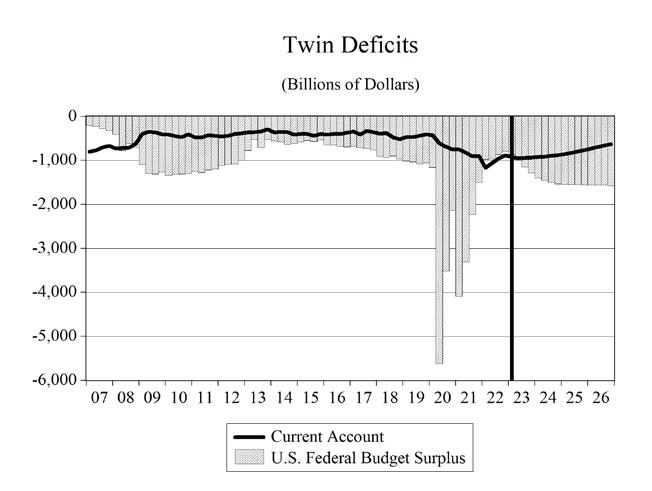
Ch ARTS Institute for Economic Forecasting 17
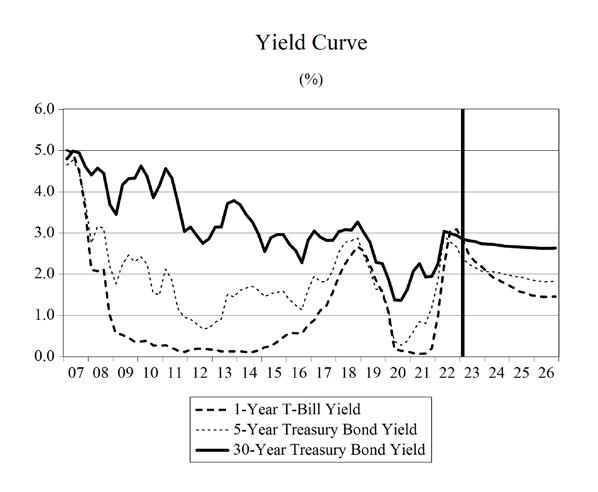
Ch ARTS 18 U.S. Forecast / Spring 2023
Table 1. Summary of the Long-Term Forecast of the U.S.
T ABLES Institute for Economic Forecasting 19
2018 2019 2020 2021 2022 2023 2024 2025 2026 2027 Composition of Real GDP, Percent Change Gross Domestic Product 2.9 2.3 -2.8 5.9 2.1 0.4 0.8 1.3 1.8 1.9 Final Sales of Domestic Product 2.8 2.3 -2.2 5.7 1.3 0.9 0.7 1.2 1.8 2.0 Total Consumption 2.9 2.0 -3.0 8.3 2.8 0.9 0.5 1.2 2.2 2.2 Durables 6.8 3.8 10.0 18.5 -0.5 -1.5 0.0 3.2 4.6 4.3 Nondurables 2.5 2.8 2.7 8.8 -0.5 -1.3 -0.1 0.4 1.2 1.3 Services 2.4 1.5 -6.6 6.3 4.5 2.1 0.7 1.1 2.1 2.2 Nonresidential Fixed Investment 6.5 3.6 -4.9 6.4 3.8 -0.8 -1.9 -1.4 0.3 2.7 Equipment & Software 6.6 1.3 -10.5 10.3 4.3 -5.5 -0.9 0.1 1.4 6.4 Information Processing Equipment 7.8 2.6 1.3 9.8 5.3 -1.5 -0.1 2.6 4.4 3.8 Computers & Peripherals 13.6 1.8 11.6 7.7 2.4 -9.1 5.4 6.5 8.0 7.0 Communications Equipment 5.4 3.6 -1.3 14.6 9.3 11.0 0.5 2.3 3.0 3.5 Industrial Equipment 5.9 3.4 -8.2 11.9 5.5 -4.0 0.6 1.3 0.5 5.1 Transportation equipment 5.4 -2.5 -31.3 8.4 11.7 0.6 -10.8 -6.3 -3.2 19.8 Aircraft -6.5 -41.6 34.5 29.0 16.2 10.8 -9.0 -0.2 2.5 4.2 Other Equipment 15.7 2.3 -31.7 15.0 12.8 -6.1 -1.0 -3.7 -2.5 -0.9 Structures 4.1 2.3 -10.1 -6.4 -6.9 -0.6 -6.4 -3.9 -0.1 1.1 Commercial & Health Care 1.3 1.5 3.2 -7.6 -12.3 -4.0 -8.7 -4.7 1.7 2.1 Manufacturing -1.8 5.6 -9.5 -0.7 3.8 2.8 -14.4 -12.5 -3.6 -5.7 Power & Communication -5.7 7.4 -1.7 -8.4 -19.4 -5.3 -10.3 -6.0 -2.9 2.9 Mining & Petroleum 27.8 -0.3 -38.4 14.0 15.3 7.2 7.0 -2.4 0.3 2.9 Other 1.4 -0.6 -12.9 -17.8 -4.5 2.4 -1.3 4.8 1.5 1.1 Residential Fixed Investment -0.6 -1.0 7.2 10.7 -10.7 -18.0 2.7 8.4 3.4 0.9 Exports 2.8 0.5 -13.2 6.1 7.2 4.9 2.8 4.6 4.0 3.6 Imports 4.2 1.1 -9.0 14.1 8.2 -1.5 -0.4 2.7 3.6 3.2 Federal Government 3.0 3.9 6.2 2.3 -2.5 2.7 -0.1 0.6 0.4 -0.1 State & Local Government 0.9 3.0 0.4 -0.5 0.6 1.6 1.2 1.1 1.1 1.0 Billions of Dollars Real GDP 18609.1 19036.1 18509.1 19609.8 20015.4 20101.5 20272.0 20536.4 20905.5 21308.6 Nominal GDP 20533.1 21381.0 21060.5 23315.1 25464.5 26660.6 27644.3 28523.0 29542.9 30623.3 Prices & Wages, Percent Change, Annual Rate GDP Deflator 2.4 1.8 1.3 4.5 7.0 4.2 2.8 1.9 1.7 1.7 Consumer Prices 2.4 1.8 1.3 4.7 8.0 5.1 3.2 1.8 1.7 1.8 Excl. Food & Energy 2.1 2.2 1.7 3.6 6.1 5.0 3.2 2.0 1.8 1.7 Producer Prices, Finished Goods 3.1 0.8 -1.3 8.9 13.4 4.7 1.9 0.8 1.1 1.3 Employment Cost Index - Total Comp. 2.9 2.7 2.7 3.6 5.1 4.2 4.0 2.7 2.5 2.4 Other Measures Oil - WTI ($ per barrel) 64.9 57.0 39.2 68.0 94.8 95.4 94.7 93.7 94.1 97.4 Productivity (%change) 1.5 1.9 4.4 2.2 -1.7 0.5 3.0 1.7 1.2 0.7 Industrial Production (%change) 3.2 -0.7 -7.0 4.9 3.8 -0.9 -2.0 0.0 1.5 1.6 Factory Operating Rate 78.1 76.9 72.4 77.1 79.0 76.5 74.8 75.0 75.9 76.6 Nonfarm Inven. Chg. (Bil. of 2012 $) 73.8 88.3 -46.9 -16.0 137.5 35.4 58.2 76.3 89.2 84.6 Consumer Sentiment Index 98.4 96.0 81.5 77.6 59.0 61.0 71.1 84.3 89.8 91.3 Light Vehicle Sales (Million units) 17.2 17.0 14.5 14.9 13.8 13.4 12.8 12.8 12.9 13.5 Housing Starts (Million units) 1.2 1.3 1.4 1.6 1.6 1.1 1.1 1.3 1.3 1.3 Existing House Sales (Million units) 4.7 4.7 5.1 5.4 4.5 3.6 3.3 3.6 4.1 4.8 Unemployment Rate (%) 3.9 3.7 8.1 5.4 3.6 4.7 6.1 6.2 5.9 5.3 Payroll Employment (%change) 1.6 1.3 -5.8 2.9 4.3 0.6 -1.8 -0.5 0.4 0.9 Federal Surplus (Unified, FY, bil. $) -907.3 -1052.2 -2957.4 -2835.3 -989.7 -1526.2 -1830.6 -1971.4 -2016.4 -2063.6 Current Account Balance (Bil. $) -439.8 -446.0 -619.7 -846.4 -958.1 -897.5 -879.0 -830.2 -823.3 -809.8 Financial Markets, NSA Federal Funds Rate (%) 1.8 2.2 0.4 0.1 1.7 5.0 3.2 1.2 0.6 0.6 3-Month Treasury Bill Rate (%) 1.9 2.1 0.4 0.0 2.0 5.0 3.0 1.2 0.6 0.6 1-Year Treasury Note Yield (%) 2.3 2.1 0.4 0.1 2.8 4.8 2.9 1.9 1.5 1.4 5-Year Treasury Note Yield (%) 2.7 2.0 0.5 0.9 3.0 3.9 2.8 2.2 2.0 1.9 10-Year Treasury Note Yield (%) 2.9 2.1 0.9 1.4 3.0 3.8 3.1 2.6 2.4 2.3 25-Year Treasury Note Yield (%) 3.1 2.6 1.6 2.1 3.1 3.8 3.5 3.0 2.8 2.8 30-Year Fixed Mortgage Rate (%) 4.6 4.1 3.2 3.0 5.4 6.8 5.7 4.7 4.3 4.1 S&P 500 Stock Index 2744.7 2912.5 3218.5 4266.8 4100.7 3963.1 3850.5 3853.9 4041.3 4261.0 (Percent change) 12.1 6.1 10.5 32.6 -3.9 -3.4 -2.8 0.1 4.9 5.4 Exchange Rate, Major Trading Partners 1.2 1.3 1.2 1.2 1.3 1.3 1.2 1.2 1.2 1.2 (Percent change (negative = depreciation)) -2.3 3.5 -1.1 -4.1 10.2 -2.9 -3.2 -2.5 -1.7 -1.9 Incomes Personal Income (Bil. of $) 17683.8 18587.0 19832.3 21294.8 21806.3 22746.4 23527.5 24534.2 25634.1 26772.2 (Percent change) 5.0 5.1 6.7 7.4 2.4 4.3 3.4 4.3 4.5 4.4 Disposable Income (Bil. of $) 15608.9 16388.6 17595.9 18633.1 18605.6 19870.3 20723.7 21667.0 22640.6 23627.3 (Percent change) 5.5 5.0 7.4 5.9 -0.1 6.8 4.3 4.6 4.5 4.4 Real Disposable Income (Bil. Of 2012 $) 14410.1 14907.9 15835.2 16130.0 15147.1 15491.9 15709.2 16160.1 16634.4 17107.3 (Percent change) 3.3 3.5 6.2 1.9 -6.1 2.3 1.4 2.9 2.9 2.8 Saving Rate (%) 7.6 8.8 16.8 11.9 3.7 4.6 5.3 6.8 7.5 8.1 After-Tax Profits (Billions of $) 1960.0 2007.4 2110.9 2749.8 2918.8 2918.4 2951.6 2978.1 3094.0 3180.7 (Percent change) 3.3 2.4 5.2 30.3 6.1 0.0 1.1 0.9 3.9 2.8
Table 1. Annual Summary of the Long-Term Forecast of the U.S.
Table 2. Real Gross Domestic Product
T ABLES 20 U.S. Forecast / Spring 2023
2018 2019 2020 2021 2022 2023 2024 2025 2026 2027 Real GDP Billions 2012 $ Gross Domestic Product 18609.1 19036.1 18509.1 19609.8 20015.4 20101.5 20272.0 20536.4 20905.5 21308.6 Final Sales of Domestic Product 18530.8 18948.5 18527.2 19581.3 19843.4 20015.2 20155.8 20407.6 20767.2 21175.8 Total Consumption 12837.3 13092.3 12700.7 13754.1 14133.3 14263.2 14332.5 14499.3 14812.7 15146.0 Durables 1677.0 1740.1 1914.2 2268.8 2258.2 2223.8 2224.8 2295.0 2401.6 2506.0 Nondurables 2903.7 2985.4 3066.7 3336.2 3318.7 3275.0 3272.0 3284.6 3325.4 3369.8 Services 8299.1 8421.0 7863.0 8361.1 8737.7 8921.1 8987.6 9085.4 9272.1 9476.1 Nonresidential Fixed Investment 2708.3 2804.6 2666.0 2835.4 2943.5 2918.8 2863.8 2822.4 2832.0 2909.4 Equipment & Software 1221.2 1236.5 1107.3 1221.8 1274.2 1203.8 1192.5 1193.8 1209.9 1286.8 Information Processing Equipment 473.7 486.1 492.4 540.4 569.0 560.3 559.7 574.1 599.5 622.2 Computers & Peripherals 124.8 127.1 141.8 152.6 156.2 142.0 149.7 159.5 172.3 184.4 Communications Equipment 201.3 208.5 205.9 235.9 258.0 286.4 288.0 294.5 303.4 314.2 Industrial Equipment 236.2 244.2 224.3 251.0 264.8 254.3 255.8 259.1 260.3 273.4 Transportation Equipment 309.2 301.6 207.2 224.5 250.7 252.2 224.9 210.9 204.1 244.5 Aircraft 48.6 28.4 38.2 49.3 57.3 63.5 57.8 57.7 59.1 61.6 Other Equipment 74.0 75.7 51.7 59.5 67.1 63.0 62.3 60.0 58.5 58.0 Structures 555.2 567.9 510.4 477.5 444.4 441.9 413.8 397.6 397.3 401.9 Commercial & Health 166.0 168.5 173.9 160.8 140.9 135.3 123.5 117.7 119.7 122.2 Manufacturing 59.8 63.2 57.2 56.8 59.0 60.6 51.9 45.4 43.8 41.3 Power & Communication 107.0 114.9 112.9 103.5 83.4 79.0 70.8 66.6 64.6 66.5 Mining & Petroleum 125.1 124.7 76.8 87.6 101.0 108.3 115.9 113.1 113.4 116.7 Other 102.8 102.1 89.0 73.2 69.9 71.6 70.6 74.0 75.2 76.0 Residential Fixed Investment 612.3 606.2 649.8 719.4 642.7 527.0 541.1 586.6 606.7 611.8 Exports 2560.1 2572.1 2231.7 2366.8 2537.8 2661.6 2734.9 2860.3 2973.4 3080.5 Imports 3425.5 3464.7 3154.3 3600.2 3894.4 3836.8 3821.4 3924.4 4067.1 4198.7 Federal Government 1231.3 1279.3 1358.9 1390.5 1355.3 1392.3 1391.2 1399.3 1405.5 1403.5 State & Local Government 1982.5 2041.1 2048.5 2037.9 2050.8 2084.2 2110.2 2134.2 2157.3 2178.0
Table 2. Real Gross Domestic Product
Table 3. Quarterly Summary of the Forecast of the U.S.
T ABLES Institute for Economic Forecasting 21
2023Q2 2023Q3 2023Q4 2024Q1 2024Q2 2024Q3 2024Q4 2025Q1 2025Q2 2025Q3 2025Q4 2026Q1 2026Q2 2026Q3 2026Q4 2027Q1 Composition of Real GDP, Percent Change, Annual Rate Gross Domestic Product -1.7 0.0 0.9 1.1 1.4 1.3 1.3 1.1 1.3 1.4 1.7 2.0 2.0 2.0 1.9 1.9 Final Sales of Domestic Product -1.9 0.3 0.5 0.9 1.3 1.2 1.2 1.1 1.3 1.4 1.6 1.9 1.9 2.0 1.9 2.0 Total Consumption -0.8 -0.5 0.2 0.8 1.0 0.9 0.9 1.0 1.4 1.6 1.9 2.5 2.3 2.5 2.3 2.2 Durables -6.2 -2.8 -1.4 0.5 2.0 3.1 3.0 2.7 3.5 3.9 4.4 5.2 4.7 5.2 4.5 4.2 Nondurables -3.2 -1.1 0.0 0.6 0.4 0.0 0.2 0.3 0.5 0.7 1.0 1.6 1.4 1.6 1.4 1.3 Services 1.0 0.0 0.5 1.0 1.1 0.8 0.8 0.9 1.3 1.5 1.8 2.4 2.2 2.4 2.2 2.2 Nonresidential Fixed Investment -5.1 -0.7 -1.7 -2.7 -1.2 -1.3 -1.4 -1.8 -1.7 -1.2 -0.4 0.4 1.1 1.7 2.5 3.2 Equipment & Software -14.1 0.4 0.0 -2.9 2.0 2.2 1.0 0.0 -1.8 -0.9 -0.4 0.6 3.3 4.0 6.2 7.6 Information Processing Equipment -2.0 0.9 -0.2 -1.6 0.6 1.5 0.8 1.7 4.6 4.9 4.9 4.2 4.1 4.4 3.9 3.8 Computers & Peripherals -7.1 9.9 6.7 5.3 5.0 6.3 6.3 5.5 7.2 8.0 8.5 8.7 7.3 7.7 7.6 7.1 Communications Equipment 6.3 4.7 -1.2 -5.0 4.2 3.2 -1.2 -0.3 6.3 5.2 2.0 1.0 4.0 3.7 2.8 3.2 Industrial Equipment -1.9 -9.0 1.7 4.4 0.2 2.7 2.4 2.9 -0.8 -0.6 -0.4 -0.9 0.5 3.2 6.5 5.3 Transportation equipment -41.6 -4.6 -9.3 -22.5 5.3 3.6 -7.4 -4.2 -13.2 -10.7 -10.8 -8.7 6.2 9.1 21.3 27.1 Aircraft -7.5 -28.4 -15.6 -5.4 1.5 -0.4 -2.9 -0.5 -1.8 4.4 3.7 2.2 0.5 3.4 5.0 5.2 Other Equipment -23.7 3.6 5.1 1.9 -2.6 -3.1 -4.2 -3.9 -3.6 -4.1 -3.6 -2.4 -1.9 -0.5 -1.1 -1.3 Structures -1.3 -3.9 -7.7 -7.1 -7.5 -6.5 -5.1 -4.1 -2.0 -1.8 -0.3 0.4 0.2 1.0 1.1 1.3 Commercial & Health Care -2.3 -14.9 -15.6 -7.2 -3.2 -6.9 -5.6 -5.2 -6.4 -1.0 1.1 2.3 5.0 2.1 3.7 0.3 Manufacturing -4.3 -0.9 -13.1 -18.6 -16.4 -20.6 -18.9 -12.8 -4.1 -6.7 -2.0 -1.3 -3.4 -5.8 -6.8 -7.0 Power & Communication -0.4 -4.7 -13.2 -11.0 -16.7 -6.2 -7.7 -6.6 -0.8 -5.3 -2.9 -3.4 -6.2 2.2 1.5 6.7 Mining & Petroleum 5.2 16.1 21.5 7.1 -1.4 -2.7 -1.4 -2.4 -4.4 -2.0 -1.1 2.2 1.2 1.4 1.8 5.2 Other -2.7 3.2 -2.9 -4.3 -3.6 3.2 6.9 5.5 7.9 3.6 1.2 0.4 -0.3 2.3 1.3 0.8 Residential Fixed Investment -19.4 -13.1 -1.0 8.4 9.9 12.3 12.1 8.4 6.3 4.7 3.2 3.6 4.1 1.8 -0.5 0.1 Exports 0.0 1.5 1.9 2.2 3.7 5.2 4.9 4.5 4.3 4.4 4.6 3.6 3.8 3.5 3.7 3.6 Imports -3.9 -5.2 -1.6 0.0 1.4 3.1 2.8 2.3 2.8 3.1 3.5 3.9 4.0 3.8 3.4 3.1 Federal Government -9.0 2.0 -0.1 0.4 0.5 0.3 0.9 0.3 0.6 0.9 0.8 0.3 0.3 0.1 0.0 0.0 State & Local Government 1.8 1.5 1.4 1.1 1.1 1.1 1.1 1.2 1.1 1.2 1.3 1.2 1.0 0.8 0.9 1.0 Billions of Dollars Real GDP 20069.1 20067.9 20111.8 20168.8 20240.8 20306.0 20372.6 20430.6 20495.6 20567.0 20652.3 20752.4 20855.2 20958.7 21055.9 21156.5 Nominal GDP 26510.8 26752.4 27010.3 27279.1 27539.1 27767.2 27991.6 28188.6 28403.1 28626.6 28873.7 29140.1 29410.9 29677.9 29942.9 30214.5 Prices & Wages, Percent Change, Annual Rate GDP Deflator 4.0 3.7 3.0 2.9 2.4 2.0 1.9 1.7 1.8 1.8 1.8 1.8 1.7 1.6 1.7 1.7 Consumer Prices 5.4 6.1 3.3 2.7 2.2 2.2 2.1 1.4 1.6 1.8 1.7 1.7 1.7 1.7 1.9 1.8 Excl. Food & Energy 5.2 4.2 3.6 3.2 2.6 2.2 2.1 1.8 1.9 1.9 1.8 1.8 1.8 1.7 1.7 1.6 Producer Prices, Finished Goods 5.6 4.0 2.1 1.1 0.9 1.1 1.1 0.4 0.8 0.9 1.1 1.2 1.1 1.0 1.2 1.4 Employment Cost Index - Total Comp. 3.4 4.2 4.5 4.2 4.0 3.3 2.7 2.5 2.5 2.5 2.5 2.4 2.5 2.4 2.4 2.5 Other Key Measures Oil - WTI ($ per barrel) 97.0 102.5 100.2 93.0 93.3 95.7 96.7 94.1 93.8 93.6 93.4 93.4 93.6 94.2 95.1 96.2 Productivity (%change) 3.9 2.8 3.2 3.7 2.6 2.1 2.2 1.6 1.0 1.3 1.5 1.3 1.3 1.0 0.6 0.5 Industrial Production (%change) 1.7 -4.4 -3.3 -2.0 -1.5 -0.9 -0.2 0.2 0.0 0.7 1.3 1.8 1.8 1.9 1.7 1.5 Factory Operating Rate 76.9 76.1 75.4 75.0 74.8 74.7 74.8 74.8 74.9 75.0 75.2 75.5 75.8 76.0 76.2 76.4 Nonfarm Inven. Chg. (Bil. of 2012 $) 40.9 16.0 35.7 45.1 55.3 62.7 69.5 72.6 75.4 77.2 79.8 83.0 88.8 92.6 92.3 89.5 Consumer Sentiment Index 57.5 58.7 62.2 65.1 68.3 73.6 77.3 81.8 84.0 85.4 86.2 88.2 89.3 90.6 91.3 91.3 Light Vehicle Sales (Million units) 13.1 13.2 13.1 12.8 12.8 12.8 12.8 12.8 12.8 12.7 12.7 12.7 12.8 12.9 13.1 13.3 Housing Starts (Million units) 1.2 1.1 1.0 1.1 1.1 1.1 1.2 1.2 1.3 1.3 1.3 1.3 1.3 1.3 1.3 1.3 Existing House Sales (Million units) 4.0 3.6 3.0 3.0 3.2 3.3 3.5 3.6 3.6 3.6 3.7 3.9 4.0 4.1 4.5 4.7 Unemployment Rate (%) 4.6 5.2 5.5 5.9 6.0 6.1 6.3 6.3 6.2 6.2 6.2 6.0 6.0 5.8 5.7 5.5 Payroll Employment (%change) -3.6 -2.6 -2.0 -1.9 -1.1 -0.9 -0.8 -0.6 0.1 0.0 0.2 0.5 0.5 0.7 0.9 1.0 Federal Surplus (NIPA Bil. $) -1503.9 -1547.2 -1593.8 -1752.6 -1828.0 -1866.6 -1875.3 -1937.0 -1968.6 -1988.3 -1991.8 -2010.7 -2015.4 -2017.6 -2022.1 -2050.2 Current Account Balance (Bil. $) -912.7 -906.1 -899.2 -887.7 -879.2 -876.9 -872.3 -849.1 -833.6 -822.7 -815.2 -818.3 -821.3 -826.2 -827.6 -820.6 Financial Markets, NSA Federal Funds Rate (%) 5.0 5.3 5.2 4.6 3.6 2.7 2.0 1.6 1.4 1.2 0.8 0.6 0.6 0.6 0.6 0.6 3-Month Treasury Bill Rate (%) 5.0 5.2 5.0 4.4 3.4 2.6 1.9 1.5 1.3 1.1 0.8 0.6 0.6 0.6 0.6 0.6 1-Year Treasury Note Yield (%) 5.0 4.8 4.3 3.7 3.1 2.6 2.3 2.1 2.0 1.8 1.6 1.5 1.5 1.4 1.4 1.4 5-Year Treasury Note Yield (%) 4.1 3.8 3.5 3.1 2.8 2.7 2.5 2.4 2.3 2.2 2.1 2.1 2.0 1.9 1.9 1.9 10-Year Treasury Note Yield (%) 3.9 3.7 3.6 3.4 3.2 3.1 2.9 2.7 2.6 2.5 2.5 2.4 2.4 2.3 2.3 2.3 25-Year Treasury Note Yield (%) 3.9 3.8 3.8 3.6 3.5 3.4 3.3 3.2 3.1 3.0 2.9 2.9 2.9 2.8 2.8 2.8 30-Year Fixed Mortgage Rate (%) 7.0 6.9 6.7 6.3 5.8 5.5 5.2 4.9 4.8 4.6 4.5 4.4 4.3 4.2 4.2 4.1 S&P 500 Stock Index 3997.6 3990.2 3939.5 3878.0 3863.6 3838.0 3822.7 3825.5 3838.3 3858.5 3893.2 3952.3 4015.3 4071.5 4126.2 4176.1 (Percent change) 7.6 -0.7 -5.0 -6.1 -1.5 -2.6 -1.6 0.3 1.3 2.1 3.6 6.2 6.5 5.7 5.5 4.9 Exchange Rate, Major Trading Partners 1.3 1.3 1.3 1.2 1.2 1.2 1.2 1.2 1.2 1.2 1.2 1.2 1.2 1.2 1.2 1.2 (Percent change (negative = depreciation)) -6.8 -4.1 -3.8 -1.7 -2.3 -3.5 -3.9 -2.3 -1.5 -1.9 -1.7 -1.4 -1.9 -1.9 -2.0 -1.9 Incomes Personal Income (Bil. of $) 22628.6 22807.1 22980.8 23205.6 23414.8 23631.2 23858.3 24139.7 24407.2 24665.5 24924.5 25224.4 25496.8 25769.7 26045.6 26361.1 (Percent change) 1.1 3.2 3.1 4.0 3.7 3.7 3.9 4.8 4.5 4.3 4.3 4.9 4.4 4.3 4.4 4.9 Disposable Income (Bil. of $) 19759.3 19949.8 20140.6 20392.1 20622.4 20833.4 21047.0 21302.7 21555.5 21788.8 22021.2 22282.9 22523.1 22758.7 22997.8 23271.1 (Percent change) 2.6 3.9 3.9 5.1 4.6 4.2 4.2 4.9 4.8 4.4 4.3 4.8 4.4 4.3 4.3 4.8 Real Disposable Income (Bil. Of 2012 $) 15481.8 15456.8 15486.4 15574.2 15667.5 15752.5 15842.9 15979.5 16108.8 16220.8 16331.4 16463.7 16579.3 16691.9 16802.7 16939.9 (Percent change) -1.6 -0.6 0.8 2.3 2.4 2.2 2.3 3.5 3.3 2.8 2.8 3.3 2.8 2.7 2.7 3.3 Saving Rate (%) 4.6 4.3 4.5 4.8 5.1 5.4 5.8 6.3 6.7 7.0 7.2 7.4 7.5 7.6 7.6 7.9 After-Tax Profits (Billions of $) 2955.6 2946.8 2912.4 2970.2 2950.8 2949.9 2935.5 2982.3 2965.8 2971.5 2992.6 3074.2 3094.8 3102.9 3104.0 3158.9 (Percent change) 14.3 -1.2 -4.6 8.2 -2.6 -0.1 -1.9 6.5 -2.2 0.8 2.9 11.4 2.7 1.1 0.1 7.3
Table 3. Quarterly Summary of the Forecast of the U.S.
Table 4. Quarterly Gross Domestic Product
T ABLES 22 U.S. Forecast / Spring 2023
2023Q2 2023Q3 2023Q4 2024Q1 2024Q2 2024Q3 2024Q4 2025Q1 2025Q2 2025Q3 2025Q4 2026Q1 2026Q2 2026Q3 2026Q4 2027Q1 Real GDP Billions 2012 $ Gross Domestic Product 20069.1 20067.9 20111.8 20168.8 20240.8 20306.0 20372.6 20430.6 20495.6 20567.0 20652.3 20752.4 20855.2 20958.7 21055.9 21156.5 Final Sales of Domestic Product 19978.0 19993.7 20017.3 20063.3 20126.6 20186.0 20247.5 20303.8 20367.2 20437.8 20521.5 20619.2 20717.0 20817.4 20915.3 21018.7 Total Consumption 14263.8 14245.3 14252.1 14281.7 14318.0 14349.1 14381.3 14416.3 14466.0 14523.0 14591.9 14682.4 14767.3 14858.7 14942.5 15024.2 Durables 2224.6 2208.9 2201.3 2204.1 2214.9 2231.9 2248.4 2263.4 2282.8 2304.5 2329.4 2359.2 2386.6 2417.1 2443.6 2468.9 Nondurables 3272.7 3264.0 3264.4 3269.4 3272.4 3272.2 3274.1 3276.5 3280.8 3286.5 3294.7 3307.4 3319.0 3331.9 3343.4 3354.2 Services 8923.3 8924.3 8935.4 8956.7 8980.4 8998.1 9015.4 9036.0 9065.8 9099.5 9140.3 9194.1 9245.2 9299.2 9350.1 9400.4 Nonresidential Fixed Investment 2914.7 2909.8 2897.3 2877.7 2868.8 2859.6 2849.3 2836.3 2824.2 2815.9 2813.1 2815.6 2823.7 2835.6 2853.1 2875.9 Equipment & Software 1191.6 1192.8 1192.9 1184.2 1190.0 1196.4 1199.5 1199.4 1194.0 1191.4 1190.3 1192.1 1201.8 1213.7 1232.1 1254.8 Information Processing Equipment 559.0 560.3 560.1 557.8 558.6 560.7 561.8 564.2 570.5 577.4 584.3 590.4 596.3 602.8 608.5 614.2 Computers & Peripherals 139.1 142.5 144.8 146.7 148.5 150.8 153.1 155.1 157.8 160.9 164.2 167.7 170.7 173.8 177.1 180.1 Communications Equipment 286.1 289.4 288.5 284.9 287.8 290.0 289.2 288.9 293.4 297.1 298.6 299.3 302.3 305.0 307.1 309.6 Industrial Equipment 256.7 250.7 251.8 254.5 254.6 256.4 257.9 259.7 259.2 258.8 258.6 258.0 258.3 260.3 264.4 267.9 Transportation Equipment 246.3 243.4 237.5 222.8 225.7 227.8 223.4 221.0 213.4 207.4 201.6 197.1 200.1 204.5 214.6 227.9 Aircraft 66.5 61.1 58.6 57.8 58.0 57.9 57.5 57.4 57.2 57.8 58.3 58.6 58.7 59.2 59.9 60.7 Other Equipment 61.4 62.0 62.8 63.1 62.6 62.2 61.5 60.9 60.3 59.7 59.1 58.8 58.5 58.4 58.3 58.1 Structures 445.9 441.6 432.8 424.8 416.6 409.6 404.3 400.1 398.1 396.3 396.0 396.4 396.6 397.6 398.7 399.9 Commercial & Health 139.3 133.8 128.2 125.8 124.8 122.6 120.9 119.2 117.3 117.0 117.3 118.0 119.5 120.1 121.2 121.3 Manufacturing 61.0 60.9 58.8 55.9 53.4 50.4 47.8 46.2 45.7 45.0 44.7 44.6 44.2 43.6 42.8 42.0 Power & Communication 80.1 79.2 76.4 74.2 70.9 69.8 68.4 67.2 67.1 66.2 65.7 65.2 64.1 64.5 64.7 65.8 Mining & Petroleum 105.2 109.3 114.7 116.7 116.3 115.5 115.1 114.4 113.1 112.5 112.2 112.8 113.2 113.6 114.1 115.5 Other 71.3 71.8 71.3 70.5 69.9 70.4 71.6 72.6 74.0 74.6 74.8 74.9 74.9 75.3 75.5 75.7 Residential Fixed Investment 529.1 510.9 509.6 520.0 532.4 548.1 563.9 575.4 584.2 591.0 595.8 601.0 607.0 609.7 608.9 609.0 Exports 2653.6 2663.4 2675.7 2690.6 2715.4 2750.2 2783.3 2814.3 2844.3 2874.9 2907.7 2933.4 2960.6 2986.0 3013.6 3040.5 Imports 3856.7 3805.4 3790.1 3790.3 3803.7 3832.6 3859.0 3880.6 3907.8 3937.6 3971.4 4010.1 4049.4 4087.3 4121.8 4153.6 Federal Government 1380.9 1387.6 1387.2 1388.5 1390.3 1391.5 1394.5 1395.4 1397.6 1400.6 1403.5 1404.6 1405.7 1405.9 1405.7 1405.6 State & Local Government 2080.7 2088.6 2095.8 2101.6 2107.2 2113.2 2118.7 2125.0 2130.8 2137.0 2143.9 2150.1 2155.2 2159.6 2164.6 2170.0
Table 4. Quarterly Gross Domestic Product
Table 5. Annual Employment
Table 5. Annual Employment
T ABLES Institute for Economic Forecasting 23
2018 2019 2020 2021 2022 2023 2024 2025 2026 2027 Millions Total Nonfarm Employment 148.9 150.9 142.2 146.3 152.6 153.5 150.8 150.1 150.6 152.1 Private Nonfarm 126.4 128.3 120.2 124.3 130.5 131.0 128.0 127.1 127.5 128.8 Mining 0.7 0.7 0.6 0.5 0.6 0.6 0.6 0.6 0.7 0.7 Construction 7.3 7.5 7.3 7.4 7.7 7.7 7.4 7.3 7.3 7.3 Manufacturing 12.7 12.8 12.2 12.4 12.8 12.6 11.8 11.5 11.5 11.7 Trade, Transportation, and Utilities 27.5 27.7 26.6 27.7 28.7 28.1 27.2 26.5 26.3 26.3 Transportation & Warehousing 5.4 5.7 5.6 6.1 6.7 6.7 6.7 6.7 6.8 6.8 Financial Activities 8.6 8.8 8.7 8.8 9.0 9.1 9.1 9.2 9.2 9.4 Education & Health 23.6 24.2 23.3 23.6 24.4 25.2 25.9 25.9 25.9 26.1 Professional & Business Services 21.0 21.3 20.4 21.4 22.6 22.2 20.8 20.6 21.0 21.6 Information 2.8 2.9 2.7 2.9 3.1 3.1 3.1 3.1 3.1 3.1 Leisure & Hospitality 16.3 16.6 13.1 14.1 15.9 16.5 16.1 16.3 16.4 16.4 Government 22.5 22.6 22.0 22.0 22.2 22.5 22.8 23.0 23.1 23.3 Federal 2.8 2.8 2.9 2.9 2.9 2.9 2.9 2.9 2.9 2.9 State & Local 19.7 19.8 19.1 19.1 19.3 19.6 19.9 20.1 20.2 20.4 Growth Rates Total Nonfarm Employment 1.6 1.3 -5.8 2.9 4.3 0.6 -1.8 -0.5 0.4 0.9 Private Nonfarm 1.8 1.5 -6.3 3.4 4.9 0.4 -2.3 -0.7 0.3 1.0 Mining 8.2 0.1 -18.4 -7.1 8.9 7.1 6.1 1.1 1.3 2.0 Construction 4.6 2.8 -3.2 2.5 4.2 -0.8 -3.9 -1.7 0.1 0.4 Manufacturing 2.0 1.0 -5.1 1.6 3.8 -1.5 -6.6 -2.7 -0.2 2.0 Trade, Transportation, and Utilities 0.7 0.4 -3.7 3.9 3.6 -2.1 -3.1 -2.5 -0.8 0.1 Transportation & Warehousing 4.8 4.4 -0.6 9.0 8.4 0.6 0.7 0.0 0.4 -0.2 Financial Activities 1.6 1.9 -0.6 1.2 2.7 0.6 -0.5 1.0 1.0 1.1 Education & Health 1.9 2.2 -3.7 1.6 3.0 3.6 2.5 0.0 0.3 0.5 Professional & Business Services 2.2 1.6 -4.5 5.0 5.6 -1.8 -6.1 -1.1 1.7 3.2 Information 0.9 0.9 -5.0 5.0 7.6 0.3 -0.2 2.0 -1.2 -0.6 Leisure & Hospitality 1.5 1.8 -20.8 7.7 12.0 4.2 -2.6 1.3 0.6 0.2 Government 0.5 0.7 -2.8 -0.1 0.9 1.5 1.2 0.9 0.7 0.7 Federal -0.1 1.1 3.6 -1.6 -0.6 0.4 0.0 0.0 0.0 0.5 State & Local 0.6 0.6 -3.7 0.2 1.2 1.6 1.3 1.0 0.8 0.8
Table 6. Quarterly Employment
T ABLES 24 U.S. Forecast / Spring 2023
2023Q2 2023Q3 2023Q4 2024Q1 2024Q2 2024Q3 2024Q4 2025Q1 2025Q2 2025Q3 2025Q4 2026Q1 2026Q2 2026Q3 2026Q4 2027Q1 Employment (Millions) Total Nonfarm Employment 153.8 152.8 152.1 151.3 150.9 150.6 150.3 150.0 150.0 150.0 150.1 150.3 150.5 150.7 151.1 151.5 Private Nonfarm 131.4 130.3 129.4 128.6 128.2 127.8 127.4 127.1 127.1 127.1 127.1 127.2 127.4 127.6 127.9 128.2 Mining 0.6 0.6 0.6 0.6 0.6 0.6 0.6 0.6 0.6 0.6 0.6 0.6 0.7 0.7 0.7 0.7 Construction 7.7 7.6 7.6 7.5 7.4 7.4 7.3 7.3 7.3 7.3 7.3 7.3 7.3 7.3 7.3 7.3 Manufacturing 12.7 12.5 12.4 12.0 11.8 11.7 11.6 11.5 11.5 11.5 11.4 11.4 11.4 11.5 11.5 11.6 Trade, Transportation, and Utilities 28.1 27.7 27.7 27.5 27.3 27.1 26.8 26.6 26.5 26.5 26.4 26.4 26.3 26.3 26.3 26.3 Transportation & Warehousing 6.7 6.7 6.7 6.7 6.8 6.7 6.7 6.7 6.7 6.7 6.7 6.8 6.8 6.8 6.8 6.8 Financial Activities 9.2 9.1 9.0 9.0 9.1 9.1 9.1 9.1 9.1 9.2 9.2 9.2 9.2 9.2 9.3 9.3 Education & Health 25.1 25.2 25.5 25.7 25.9 25.9 25.9 25.9 25.9 25.9 25.9 25.9 25.9 25.9 26.0 26.0 Professional & Business Services 22.4 21.9 21.4 21.1 20.8 20.7 20.6 20.6 20.6 20.6 20.7 20.8 20.9 21.0 21.2 21.3 Information 3.1 3.1 3.1 3.1 3.1 3.1 3.1 3.1 3.1 3.2 3.1 3.1 3.1 3.1 3.1 3.1 Leisure & Hospitality 16.6 16.6 16.3 16.1 16.1 16.1 16.1 16.2 16.3 16.3 16.3 16.3 16.4 16.4 16.5 16.4 Government 22.5 22.5 22.6 22.7 22.7 22.8 22.9 22.9 22.9 23.0 23.0 23.1 23.1 23.1 23.2 23.2 Federal 2.9 2.9 2.9 2.9 2.9 2.9 2.9 2.9 2.9 2.9 2.9 2.9 2.9 2.9 2.9 2.9 State & Local 19.6 19.7 19.7 19.8 19.9 19.9 20.0 20.0 20.1 20.1 20.1 20.2 20.2 20.3 20.3 20.3 Growth Rates Total Nonfarm Employment -3.6 -2.6 -2.0 -1.9 -1.1 -0.9 -0.8 -0.6 0.1 0.0 0.2 0.5 0.5 0.7 0.9 1.0 Private Nonfarm -4.5 -3.3 -2.5 -2.5 -1.5 -1.2 -1.1 -0.9 -0.1 -0.1 0.1 0.5 0.4 0.7 0.9 1.0 Mining 6.8 8.0 9.9 7.1 4.4 1.8 1.3 0.8 0.2 0.7 0.6 1.2 2.1 2.2 2.1 2.2 Construction -7.1 -5.8 -2.6 -4.3 -4.4 -1.9 -1.2 -2.8 -0.8 -0.6 -0.1 0.3 0.7 0.5 -0.2 0.4 Manufacturing -8.5 -4.0 -5.7 -10.2 -6.2 -4.3 -2.7 -3.0 -1.0 -1.7 -1.3 0.0 0.3 1.2 2.1 2.7 Trade, Transportation, and Utilities -8.8 -5.2 -0.7 -2.4 -3.0 -3.1 -3.6 -3.0 -1.6 -0.7 -0.9 -1.0 -0.9 0.0 0.1 0.0 Transportation & Warehousing -3.3 -2.6 1.6 3.7 0.9 -0.5 -1.1 0.7 -0.3 0.5 0.3 0.6 0.3 0.5 0.2 -0.6 Financial Activities 0.4 -2.6 -4.5 0.4 2.0 1.3 1.1 1.4 0.5 0.4 0.9 2.1 0.6 0.3 1.6 2.4 Education & Health 0.7 2.0 3.6 4.0 2.2 1.2 -0.4 -0.4 -0.5 0.0 0.2 0.7 0.1 0.2 0.2 0.6 Professional & Business Services -8.3 -9.5 -8.6 -6.1 -4.0 -2.1 -1.9 -0.7 -0.7 0.4 1.3 2.3 2.0 2.4 3.0 3.4 Information -8.0 3.0 -0.7 1.6 0.4 -3.5 2.0 5.5 2.6 2.2 -1.4 -1.8 -2.7 -2.1 -1.9 0.0 Leisure & Hospitality 2.1 -1.3 -5.8 -6.2 -0.3 0.3 1.9 0.6 4.1 0.1 0.1 -0.2 1.1 1.1 0.7 -1.0 Government 1.5 1.3 1.2 1.2 1.1 1.0 1.0 0.9 0.7 0.7 0.7 0.7 0.7 0.7 0.7 0.9 Federal 0.0 0.0 0.0 0.0 0.0 0.0 0.0 0.0 0.0 0.0 0.0 0.0 0.0 0.0 0.0 1.9 State & Local 1.7 1.5 1.4 1.3 1.2 1.2 1.1 1.0 0.9 0.8 0.8 0.8 0.8 0.8 0.8 0.8
Table 6. Quarterly Employment
Table 7. Quarterly Implicit
Table 7. Quarterly Implicit Price Deflators (2012=100)
Price Deflators (2012=100)
T ABLES Institute for Economic Forecasting 25
2023Q2 2023Q3 2023Q4 2024Q1 2024Q2 2024Q3 2024Q4 2025Q1 2025Q2 2025Q3 2025Q4 2026Q1 2026Q2 2026Q3 2026Q4 2027Q1 GDP 132.1 133.3 134.3 135.3 136.1 136.7 137.4 138.0 138.6 139.2 139.8 140.4 141.0 141.6 142.2 142.8 Consumption 127.6 129.1 130.1 130.9 131.6 132.3 132.8 133.3 133.8 134.3 134.8 135.3 135.9 136.3 136.9 137.4 Durables 96.2 95.6 94.9 94.1 93.2 92.2 91.4 90.8 90.3 89.8 89.3 88.9 88.4 87.9 87.4 87.0 Motor Vehicles 123.1 122.3 121.0 120.4 119.5 118.5 117.5 117.0 116.9 116.9 116.9 117.0 117.1 117.1 117.2 117.3 Furniture 101.8 101.3 101.3 101.4 100.8 100.0 99.3 98.6 98.0 97.5 96.9 96.2 95.5 94.7 94.0 93.1 Other Durables 87.6 87.4 86.8 86.1 85.3 84.8 84.4 84.1 83.8 83.3 83.0 82.6 82.2 81.9 81.6 81.3 Nondurables 115.4 117.2 117.8 118.1 118.4 118.9 119.3 119.4 119.6 119.9 120.1 120.4 120.7 120.9 121.2 121.5 Food 129.5 130.0 130.5 130.7 130.8 130.8 131.0 131.3 131.6 132.1 132.5 133.0 133.4 133.8 134.3 134.7 Clothing & Shoes 101.2 100.2 100.6 100.1 100.5 100.5 100.6 100.8 100.7 100.6 100.6 100.7 100.8 101.0 100.9 101.2 Gasoline & Oil 102.2 113.5 113.4 113.5 113.8 115.7 116.8 115.0 114.7 114.6 114.5 114.4 114.4 114.6 115.3 116.2 Fuel 122.6 129.3 129.6 129.6 130.9 131.7 131.9 130.4 129.4 128.7 128.4 128.2 128.2 128.3 128.8 129.6 Services 137.7 139.5 141.0 142.5 143.7 144.8 145.8 146.7 147.5 148.3 149.2 150.0 150.9 151.7 152.5 153.4 Housing 148.7 151.0 152.9 154.8 156.3 157.7 158.8 159.9 161.0 162.1 163.2 164.2 165.2 166.3 167.3 168.4 Electricity 141.5 142.5 144.0 145.6 145.2 145.6 146.6 147.6 147.8 148.1 149.3 150.0 150.5 151.0 152.3 153.4 Natural Gas 158.2 158.8 159.9 159.6 158.7 155.5 156.9 159.1 157.0 158.7 160.7 162.4 164.3 166.7 172.6 175.4 Water & Sewer 152.5 156.3 159.8 163.2 166.0 168.3 170.2 172.1 174.1 175.9 177.9 179.9 181.9 183.9 186.0 188.2 Telephone 67.6 67.5 66.7 66.0 65.5 64.8 64.0 63.3 62.6 62.1 61.5 60.7 59.8 58.9 58.3 57.6 Transportation 137.1 138.9 140.4 141.6 142.7 143.7 144.5 145.3 146.1 146.7 147.3 148.0 148.6 149.1 149.6 150.1 Other Services 136.2 138.2 139.9 141.5 143.0 144.1 145.3 146.1 146.8 147.6 148.3 149.0 149.8 150.5 151.3 152.1
Table 8. Percent Change in Implicit Price Deflators
T ABLES 26 U.S. Forecast / Spring 2023
2023Q1 2023Q2 2023Q3 2023Q4 2024Q1 2024Q2 2024Q3 2024Q4 2025Q1 2025Q2 2025Q3 2025Q4 2026Q1 2026Q2 2026Q3 2026Q4 2027Q1 GDP 4.1 4.0 3.7 3.0 2.9 2.4 2.0 1.9 1.7 1.8 1.8 1.8 1.8 1.7 1.6 1.7 1.7 Consumption 4.6 4.2 4.6 3.1 2.7 2.1 1.9 1.8 1.4 1.5 1.5 1.5 1.5 1.5 1.5 1.5 1.5 Durables -1.4 -1.8 -2.2 -3.2 -3.1 -3.8 -4.2 -3.5 -2.6 -2.1 -2.1 -2.1 -2.1 -2.1 -2.2 -2.2 -2.1 Motor Vehicles -4.8 -5.3 -2.3 -4.2 -2.2 -2.9 -3.3 -3.3 -1.8 -0.1 -0.1 0.2 0.2 0.2 0.1 0.2 0.6 Furniture 1.8 -0.1 -1.9 0.0 0.5 -2.4 -3.1 -3.0 -2.7 -2.4 -2.1 -2.4 -2.6 -2.9 -3.4 -2.9 -3.7 Other Durables 5.1 0.0 -1.1 -2.5 -3.1 -3.7 -2.5 -1.7 -1.6 -1.5 -2.0 -1.9 -1.9 -1.6 -1.4 -1.5 -1.4 Nondurables 1.4 1.6 6.5 1.8 1.3 0.9 1.7 1.4 0.1 0.8 0.9 0.9 0.9 0.9 0.9 1.0 0.9 Food 3.8 2.0 1.8 1.4 0.6 0.3 0.2 0.6 0.8 1.1 1.3 1.4 1.4 1.3 1.3 1.3 1.2 Clothing & Shoes 4.0 0.7 -4.0 2.0 -2.1 1.6 0.1 0.2 0.9 -0.3 -0.3 -0.2 0.2 0.6 0.8 -0.2 1.1 Gasoline & Oil -15.5 5.0 51.8 -0.3 0.2 1.0 7.0 3.9 -6.1 -0.9 -0.5 -0.4 -0.3 0.0 1.0 2.3 3.0 Fuel -40.6 5.0 23.8 1.0 -0.1 4.0 2.5 0.6 -4.4 -3.1 -2.0 -1.0 -0.5 -0.2 0.4 1.6 2.4 Services 6.9 6.2 5.2 4.6 4.2 3.5 3.0 2.8 2.4 2.3 2.3 2.3 2.3 2.2 2.2 2.3 2.2 Housing 8.9 9.0 6.4 5.2 4.8 4.2 3.5 2.9 2.8 2.8 2.7 2.6 2.6 2.6 2.5 2.5 2.5 Electricity 9.2 11.3 2.8 4.2 4.6 -0.9 1.0 2.9 2.8 0.3 0.9 3.3 2.0 1.2 1.3 3.6 2.7 Natural Gas 12.7 -14.3 1.5 2.8 -0.6 -2.3 -7.9 3.7 5.6 -5.1 4.5 5.0 4.4 4.9 6.0 14.8 6.7 Water & Sewer 7.5 9.0 10.4 9.2 8.7 7.2 5.7 4.5 4.6 4.6 4.4 4.5 4.6 4.5 4.6 4.7 4.7 Telephone 5.2 6.9 -1.0 -4.3 -4.5 -2.6 -4.4 -4.9 -4.5 -4.2 -3.0 -4.0 -4.7 -6.1 -5.8 -4.3 -4.5 Transportation 11.6 6.9 5.3 4.4 3.4 3.2 2.7 2.5 2.1 2.2 1.8 1.8 1.7 1.6 1.5 1.4 1.3 Other Services 5.9 6.9 5.9 5.0 4.8 4.1 3.3 3.2 2.3 2.0 2.0 2.0 1.9 2.1 2.1 2.1 2.0
Table 8. Percent Change in Implicit Price Deflators
Table 9. Annual Implicit Price Deflators (2012=100)
Table 9. Annual Implicit Price Deflators (2012=100)
T ABLES Institute for Economic Forecasting 27
2018 2019 2020 2021 2022 2023 2024 2025 2026 2027 GDP 110.3 112.3 113.8 118.9 127.2 132.6 136.4 138.9 141.3 143.7 Consumption 108.3 109.9 111.1 115.6 122.9 128.3 131.9 134.1 136.1 138.1 Durables 87.7 86.8 86.0 90.8 96.7 95.8 92.7 90.1 88.2 86.2 Motor Vehicles 98.3 99.0 100.7 112.2 125.2 122.8 119.0 116.9 117.1 117.5 Furniture 86.5 87.2 87.8 92.4 101.1 101.6 100.4 97.7 95.1 91.9 Other Durables 87.1 85.2 82.8 83.5 85.4 87.3 85.2 83.5 82.1 81.0 Nondurables 99.3 99.2 98.6 103.0 113.2 116.3 118.7 119.7 120.8 121.9 Food 103.4 104.4 108.0 111.4 123.1 129.7 130.8 131.9 133.6 135.3 Clothing & Shoes 99.3 97.9 92.9 94.8 99.8 100.8 100.4 100.7 100.8 101.2 Gasoline & Oil 78.0 75.3 64.2 85.8 112.7 107.5 114.9 114.7 114.7 117.2 Fuel 80.8 77.1 59.9 79.0 128.9 125.6 131.0 129.2 128.4 130.4 Services 115.1 117.8 120.1 124.5 130.7 138.5 144.2 147.9 151.3 154.6 Housing 119.8 123.9 127.5 130.7 138.2 149.6 156.9 161.6 165.8 170.0 Electricity 108.3 108.5 109.1 113.8 129.0 141.4 145.8 148.2 151.0 154.4 Natural Gas 104.3 102.8 103.0 120.3 151.7 160.3 157.7 158.8 166.5 179.2 Water & Sewer 124.9 128.9 133.0 137.8 144.0 154.5 166.9 175.0 182.9 191.5 Telephone 76.0 72.1 70.5 68.8 66.5 67.1 65.1 62.4 59.4 56.5 Transportation 106.9 109.1 107.9 112.4 125.7 137.8 143.1 146.4 148.8 150.7 Other Services 114.8 117.5 120.2 123.4 129.6 137.1 143.5 147.2 150.2 153.3
Table 10. Percent Change in Implicit Price Deflators
Table 10. Percent Change in Implicit Price Deflators
T ABLES 28 U.S. Forecast / Spring 2023
2018 2019 2020 2021 2022 2023 2024 2025 2026 2027 GDP 2.4 1.8 1.3 4.5 7.0 4.2 2.8 1.9 1.7 1.7 Consumption 2.1 1.5 1.1 4.0 6.3 4.4 2.8 1.6 1.5 1.5 Durables -1.5 -1.0 -0.9 5.6 6.5 -0.9 -3.2 -2.9 -2.1 -2.2 Motor Vehicles 0.0 0.8 1.7 11.4 11.7 -2.0 -3.1 -1.7 0.1 0.4 Furniture -1.1 0.7 0.8 5.3 9.4 0.4 -1.2 -2.6 -2.7 -3.4 Other Durables -1.8 -2.2 -2.7 0.8 2.3 2.3 -2.5 -1.9 -1.7 -1.4 Nondurables 1.9 -0.1 -0.7 4.5 9.9 2.8 2.0 0.9 0.9 0.9 Food 0.5 1.0 3.4 3.2 10.5 5.4 0.9 0.8 1.3 1.2 Clothing & Shoes 0.1 -1.4 -5.1 2.1 5.2 0.9 -0.3 0.3 0.2 0.4 Gasoline & Oil 13.2 -3.4 -14.8 33.7 31.3 -4.6 6.9 -0.2 0.0 2.2 Fuel 21.0 -4.6 -22.3 31.9 63.1 -2.5 4.3 -1.4 -0.6 1.6 Services 2.8 2.4 2.0 3.6 5.0 5.9 4.1 2.6 2.3 2.2 Housing 3.4 3.4 2.9 2.5 5.8 8.2 4.9 3.0 2.6 2.5 Electricity 0.7 0.2 0.6 4.3 13.3 9.7 3.1 1.7 1.9 2.3 Natural Gas 0.0 -1.5 0.2 16.8 26.1 5.7 -1.6 0.7 4.8 7.6 Water & Sewer 3.5 3.2 3.2 3.6 4.5 7.3 8.1 4.8 4.5 4.7 Telephone -2.7 -5.0 -2.2 -2.4 -3.4 0.9 -3.0 -4.2 -4.7 -4.8 Transportation 2.1 2.0 -1.1 4.2 11.9 9.6 3.9 2.3 1.7 1.3 Other Services 2.5 2.4 2.3 2.7 5.0 5.8 4.7 2.6 2.0 2.1
Table 11. Personal Income and its Components
Table 11. Personal Income and its Components
T ABLES Institute for Economic Forecasting 29
2018 2019 2020 2021 2022 2023 2024 2025 2026 2027 Personal Income Billions Current Dollars Personal Income 17683.8 18587.0 19832.3 21294.8 21806.3 22746.4 23527.5 24534.2 25634.1 26772.2 Wages & Salaries 10957.9 11448.1 11592.7 12538.5 13601.5 14236.3 14604.2 15067.3 15655.2 16320.1 Other Labor Income 1433.1 1472.9 1476.2 1550.3 1612.5 1662.0 1706.1 1762.1 1830.5 1907.1 Nonfarm Income 1539.5 1572.3 1597.9 1702.2 1756.8 1795.2 1839.4 1899.1 1999.0 2115.5 Farm Income 29.2 29.1 45.2 51.3 91.7 95.6 97.0 101.6 100.7 99.2 Rental Income 680.0 698.2 719.8 723.8 781.3 810.9 765.7 774.5 836.5 892.3 Dividends 1253.4 1460.9 1448.1 1543.9 1616.8 1651.3 1568.1 1602.2 1682.0 1772.5 Interest Income 1608.9 1658.1 1647.3 1658.6 1724.8 1888.2 2172.8 2437.5 2562.2 2614.6 Transfer Payments 2976.6 3144.8 4231.2 4617.3 3910.0 4026.6 4284.7 4513.6 4731.9 4955.8 Personal Social Insurance Tax 736.8 773.9 790.9 842.7 911.9 954.5 980.1 1011.1 1050.0 1085.0 Percent Change, Annual Rate Personal Income 5.0 5.1 6.7 7.4 2.4 4.3 3.4 4.3 4.5 4.4 Wages & Salaries 5.1 4.5 1.3 8.2 8.5 4.7 2.6 3.2 3.9 4.2 Other Labor Income 6.5 2.8 0.2 5.0 4.0 3.1 2.6 3.3 3.9 4.2 Nonfarm Income 5.0 2.1 1.6 6.5 3.2 2.2 2.5 3.2 5.3 5.8 Farm Income -25.3 -0.2 55.0 13.6 78.6 4.2 1.5 4.7 -1.0 -1.5 Rental Income 4.5 2.7 3.1 0.6 7.9 3.8 -5.6 1.1 8.0 6.7 Dividends 8.6 16.6 -0.9 6.6 4.7 2.1 -5.0 2.2 5.0 5.4 Interest Income 3.9 3.1 -0.7 0.7 4.0 9.5 15.1 12.2 5.1 2.0 Transfer Payments 4.2 5.7 34.5 9.1 -15.3 3.0 6.4 5.3 4.8 4.7 Personal Social Insurance Tax 6.1 5.0 2.2 6.6 8.2 4.7 2.7 3.2 3.9 3.3
Table 12. Personal Consumption Expenditures (Current Dollars)
T ABLES 30 U.S. Forecast / Spring 2023
Table 12. Personal Consumption Expenditures (Current Dollars) 2023Q1 2023Q2 2023Q3 2023Q4 2024Q1 2024Q2 2024Q3 2024Q4 2025Q1 2025Q2 2025Q3 2025Q4 2026Q1 2026Q2 2026Q3 2026Q4 2027Q1 Consumer Expenditures by Type Billions Current Dollars Consumer spending on… 18051.3 18204.7 18386.1 18535.3 18699.9 18846.2 18977.3 19105.4 19218.7 19357.3 19508.1 19675.7 19872.0 20061.5 20259.1 20451.8 20639.4 2183.8 2139.6 2112.6 2088.4 2074.7 2064.8 2058.6 2055.3 2055.1 2061.5 2069.9 2081.3 2096.6 2109.7 2124.9 2136.3 2147.0 531.7 527.8 527.3 528.4 527.0 524.0 521.7 519.6 517.6 516.3 514.9 513.6 514.6 515.8 517.6 519.5 521.7 242.9 240.9 239.0 237.2 235.3 234.8 233.2 231.0 230.2 229.0 227.6 225.8 224.2 222.9 221.9 220.2 219.4 713.1 680.4 655.3 634.0 623.0 616.6 613.4 612.5 612.8 617.4 623.1 630.5 639.6 646.7 655.4 660.6 665.5 195.3 193.7 194.1 193.8 194.2 195.2 196.0 196.8 198.3 199.2 199.9 200.6 201.1 201.1 200.9 200.5 200.1 3791.9 3776.9 3826.9 3844.6 3862.7 3875.4 3891.5 3907.5 3911.6 3924.2 3939.5 3957.9 3981.8 4004.6 4029.3 4053.8 4076.1 507.3 504.6 504.1 510.7 516.7 521.4 525.6 529.0 534.2 539.2 545.4 549.8 556.4 562.0 566.6 568.2 573.9 28.3 29.5 30.7 30.2 30.2 30.4 30.6 30.9 30.6 30.4 30.2 30.2 30.1 30.1 30.1 30.1 30.2 403.6 403.9 436.6 434.3 435.1 434.2 437.8 440.4 432.3 429.1 426.5 424.4 423.1 421.6 421.1 421.5 422.3 1312.9 1307.3 1310.6 1313.8 1315.3 1316.0 1315.7 1316.5 1317.6 1320.8 1325.1 1330.6 1337.7 1344.5 1351.6 1358.5 1364.8 all goods & services durable goods furniture and appliances information processing equipment motor vehicles and parts other durable goods nondurables clothing & shoes fuel, oil, & coal gasoline & motor oil food other nondurable goods 1539.9 1531.4 1544.9 1555.7 1565.4 1573.4 1581.8 1590.8 1596.8 1604.7 1612.2 1623.0 1634.5 1646.4 1660.0 1675.4 1685.0 Consumer Expenditures by Type Billions 2012 Dollars Consumer spending on… all goods & services 14291.5 14263.8 14245.3 14252.1 14281.7 14318.0 14349.1 14381.3 14416.3 14466.0 14523.0 14591.9 14682.4 14767.3 14858.7 14942.5 15024.2 durable goods 2260.4 2224.6 2208.9 2201.3 2204.1 2214.9 2231.9 2248.4 2263.4 2282.8 2304.5 2329.4 2359.2 2386.6 2417.1 2443.6 2468.9 furniture and appliances 522.1 518.4 520.4 521.6 519.6 519.7 521.5 523.4 525.0 526.9 528.2 530.1 534.6 539.9 546.4 552.6 560.1 information processing equipment 412.1 408.8 397.5 400.5 402.5 409.1 414.2 415.4 418.3 420.0 421.1 421.0 421.5 423.0 425.5 425.7 429.5 motor vehicles and parts 571.7 552.9 535.6 523.8 517.5 516.0 517.7 521.3 523.9 528.0 533.0 539.1 546.6 552.4 559.6 563.8 567.1 other durable goods 245.4 243.4 246.8 248.7 252.7 256.9 260.7 263.9 267.3 270.1 273.1 275.8 278.4 279.9 281.1 282.2 282.9 nondurables 3299.0 3272.7 3264.0 3264.4 3269.4 3272.4 3272.2 3274.1 3276.5 3280.8 3286.5 3294.7 3307.4 3319.0 3331.9 3343.4 3354.2 clothing & shoes 502.2 498.7 503.3 507.4 516.2 518.8 522.9 526.0 530.0 535.3 541.9 546.5 552.8 557.6 561.0 562.9 567.1 fuel oil & coal 23.4 24.1 23.7 23.3 23.3 23.2 23.3 23.4 23.5 23.5 23.5 23.5 23.5 23.5 23.4 23.4 23.3 gasoline & motor oil 399.6 395.1 384.7 383.0 383.5 381.7 378.3 377.0 376.0 374.0 372.2 370.8 369.9 368.6 367.3 365.6 363.5 food 1019.1 1009.9 1007.9 1006.9 1006.5 1006.4 1005.6 1004.7 1003.6 1003.3 1003.4 1004.1 1006.0 1007.8 1009.9 1011.7 1013.3 other nondurable goods 1326.8 1317.3 1316.7 1316.9 1314.4 1317.1 1317.5 1318.9 1320.2 1321.9 1323.7 1328.6 1334.7 1341.5 1350.3 1359.7 1367.3 Real Consumer Expenditures Annual Growth Rate Consumer spending on… all goods & services 1.8 -0.8 -0.5 0.2 0.8 1.0 0.9 0.9 1.0 1.4 1.6 1.9 2.5 2.3 2.5 2.3 2.2 durable goods 3.0 -6.2 -2.8 -1.4 0.5 2.0 3.1 3.0 2.7 3.5 3.9 4.4 5.2 4.7 5.2 4.5 4.2 furniture and appliances 1.8 -2.8 1.5 0.9 -1.5 0.1 1.3 1.5 1.2 1.5 1.0 1.4 3.5 4.0 4.9 4.6 5.6 information processing equipment 5.2 -3.2 -10.6 3.0 2.0 6.8 5.1 1.1 2.9 1.6 1.0 -0.1 0.5 1.4 2.3 0.2 3.6 motor vehicles and parts 4.8 -12.5 -12.0 -8.5 -4.7 -1.2 1.3 2.8 2.0 3.1 3.8 4.7 5.7 4.3 5.4 3.0 2.4 other durable goods -3.8 -3.2 5.7 3.2 6.6 6.8 6.0 5.0 5.3 4.4 4.4 4.1 3.7 2.3 1.7 1.6 0.9 nondurables -1.8 -3.2 -1.1 0.0 0.6 0.4 0.0 0.2 0.3 0.5 0.7 1.0 1.6 1.4 1.6 1.4 1.3 clothing & shoes 4.5 -2.8 3.7 3.4 7.1 2.0 3.2 2.4 3.0 4.1 5.0 3.5 4.7 3.5 2.5 1.4 3.0 fuel oil & coal 41.2 12.6 -5.9 -7.0 -0.2 -0.7 0.3 3.1 0.4 0.6 0.0 -0.1 -0.5 0.0 -0.6 -1.0 -1.6 gasoline & motor oil -12.0 -4.4 -10.1 -1.8 0.6 -1.9 -3.4 -1.4 -1.1 -2.0 -1.9 -1.5 -0.9 -1.5 -1.4 -1.8 -2.2 food -3.0 -3.6 -0.8 -0.4 -0.2 0.0 -0.3 -0.4 -0.4 -0.1 0.1 0.3 0.8 0.7 0.9 0.7 0.6 other nondurable goods -0.6 -2.8 -0.2 0.0 -0.8 0.8 0.1 0.4 0.4 0.5 0.5 1.5 1.8 2.1 2.6 2.8 2.2
Consumer Expenditures by Type Billions 2012 Dollars
Consumption Expenditures
T ABLES Institute for Economic Forecasting 31
2018 2019 2020 2021 2022 2023 2024 2025 2026 2027 Consumer Expenditures by Type Billions Current Dollars Consumer spending on… 13905.0 14392.7 14116.2 15902.6 17360.4 18294.4 18907.2 19439.9 20161.1 20918.4 1470.7 1510.5 1646.8 2060.2 2184.7 2131.1 2063.3 2066.9 2116.9 2161.1 346.0 360.5 411.9 495.0 525.5 528.8 523.1 515.6 516.9 523.3 139.7 153.8 188.9 227.8 242.3 240.0 233.6 228.2 222.3 218.7 520.9 517.0 533.9 688.7 723.0 670.7 616.4 620.9 650.6 671.5 145.2 145.4 135.7 186.5 197.8 194.2 195.6 199.5 200.9 200.0 2884.5 2963.0 3023.3 3436.3 3754.9 3810.1 3884.3 3933.3 4017.4 4107.4 391.3 397.8 358.4 461.3 491.2 506.7 523.2 542.1 563.3 579.9 21.9 20.9 17.5 21.8 29.6 29.7 30.5 30.4 30.1 30.3 328.4 316.2 230.3 347.6 463.1 419.6 436.9 428.1 421.8 422.5 999.7 1030.8 1126.1 1205.0 1277.4 1311.2 1315.9 1323.5 1348.1 1373.7 all goods & services durable goods furniture and appliances information processing equipment motor vehicles and parts other durable goods nondurables clothing & shoes fuel, oil, & coal gasoline & motor oil food other nondurable goods 1143.1 1197.2 1291.1 1400.5 1493.6 1543.0 1577.8 1609.2 1654.1 1701.0
Table 13. Personal
Table 13. Personal Consumption Expenditures
Consumer spending on… all goods & services 12837.3 13092.3 12700.7 13754.1 14133.3 14263.2 14332.5 14499.3 14812.7 15146.0 durable goods 1677.0 1740.1 1914.2 2268.8 2258.2 2223.8 2224.8 2295.0 2401.6 2506.0 furniture and appliances 399.8 413.5 469.0 535.4 519.2 520.6 521.1 527.5 543.4 569.3 information processing equipment 191.9 226.3 302.8 369.5 399.0 404.7 410.3 420.1 423.9 436.1 motor vehicles and parts 530.1 522.0 530.3 614.0 574.6 546.0 518.1 531.0 555.6 571.3 other durable goods 179.4 187.1 181.2 244.9 255.8 246.1 258.5 271.6 280.4 284.7 nondurables 2903.7 2985.4 3066.7 3336.2 3318.7 3275.0 3272.0 3284.6 3325.4 3369.8 clothing & shoes 394.1 406.2 385.7 486.4 492.2 502.9 521.0 538.4 558.6 572.8 fuel oil & coal 27.1 27.1 29.1 27.6 23.1 23.6 23.3 23.5 23.4 23.2 gasoline & motor oil 421.1 419.9 358.8 405.1 411.9 390.6 380.1 373.3 367.8 360.4 food 966.8 987.1 1043.1 1082.0 1038.1 1011.0 1005.8 1003.6 1008.9 1015.5 other nondurable goods 1082.5 1129.0 1205.5 1299.3 1323.6 1319.4 1317.0 1323.6 1346.5 1378.5 Real Consumer Expenditures Annual Growth Rate Consumer spending on… all goods & services 2.9 2.0 -3.0 8.3 2.8 0.9 0.5 1.2 2.2 2.2 durable goods 6.8 3.8 10.0 18.5 -0.5 -1.5 0.0 3.2 4.6 4.3 furniture and appliances 8.4 3.4 13.4 14.2 -3.0 0.3 0.1 1.2 3.0 4.8 information processing equipment 12.7 17.9 33.8 22.1 8.0 1.4 1.4 2.4 0.9 2.9 motor vehicles and parts 3.7 -1.5 1.6 15.8 -6.4 -5.0 -5.1 2.5 4.6 2.8 other durable goods 6.4 4.3 -3.1 35.1 4.5 -3.8 5.1 5.0 3.3 1.5 nondurables 2.5 2.8 2.7 8.8 -0.5 -1.3 -0.1 0.4 1.2 1.3 clothing & shoes 2.7 3.1 -5.0 26.1 1.2 2.2 3.6 3.4 3.7 2.6 fuel oil & coal -3.9 -0.3 7.7 -5.3 -16.4 2.4 -1.3 0.8 -0.2 -1.0 gasoline & motor oil -0.3 -0.3 -14.6 12.9 1.7 -5.2 -2.7 -1.8 -1.4 -2.0 food 2.2 2.1 5.7 3.7 -4.1 -2.6 -0.5 -0.2 0.5 0.7 other nondurable goods 3.5 4.3 6.8 7.8 1.9 -0.3 -0.2 0.5 1.7 2.4
Table 14. Business Fixed Investment
Table 14. Business Fixed Investment
T ABLES 32 U.S. Forecast / Spring 2023
2018 2019 2020 2021 2022 2023 2024 2025 2026 2027 Billions Current Dollars Business Fixed Investment 2784.7 2921.1 2797.9 3025.0 3345.1 3453.9 3433.5 3400.8 3432.2 3543.9 Producers Dur. Equipment 1193.2 1209.8 1077.8 1194.0 1322.5 1293.4 1282.2 1284.1 1305.2 1392.2 Nonresidential Structures 633.6 674.7 614.4 598.2 648.2 710.3 694.1 679.8 692.2 713.1 Non-Farm Buildings 346.7 369.1 362.4 346.6 385.6 430.2 409.7 399.6 409.6 413.0 Commercial 163.8 174.4 185.2 183.1 198.1 215.3 193.3 180.4 187.3 192.7 Industrial 69.6 77.9 72.6 75.9 96.5 112.8 102.6 92.0 90.1 86.6 Other Buildings 113.2 116.8 104.7 87.7 90.9 102.1 113.7 127.3 132.2 133.6 Utilities 131.8 144.6 145.8 141.6 130.3 135.5 130.4 129.1 129.8 137.8 Mines & Wells 127.0 129.6 75.1 78.0 97.2 104.7 113.5 110.1 111.4 119.2 Billions 2012 Dollars Business Fixed Investment 2708.3 2804.6 2666.0 2835.4 2943.5 2918.8 2863.8 2822.4 2832.0 2909.4 Producers Dur. Equipment 1221.2 1236.5 1107.3 1221.8 1274.2 1203.8 1192.5 1193.8 1209.9 1286.8 Nonresidential Structures 555.2 567.9 510.4 477.5 444.4 441.9 413.8 397.6 397.3 401.9 Non-Farm Buildings 292.5 296.4 283.5 254.5 234.3 231.0 212.2 204.8 207.1 207.7 Commercial 141.7 144.0 149.8 138.5 121.2 116.2 101.7 93.8 95.1 96.9 Industrial 59.8 63.2 57.2 56.8 59.0 60.6 51.9 45.4 43.8 41.3 Other Buildings 90.9 89.3 77.3 60.9 55.7 55.8 60.4 67.6 70.4 71.9 Utilities 118.8 125.5 122.7 112.3 92.2 87.8 79.3 74.9 73.1 75.1 Mines & Wells 125.1 124.7 76.8 87.6 101.0 108.3 115.9 113.1 113.4 116.7 Annual Growth Rate Business Fixed Investment 6.5 3.6 -4.9 6.4 3.8 -0.8 -1.9 -1.4 0.3 2.7 Producers Dur. Equipment 6.6 1.3 -10.5 10.3 4.3 -5.5 -0.9 0.1 1.4 6.4 Nonresidential Structures 4.1 2.3 -10.1 -6.4 -6.9 -0.6 -6.4 -3.9 -0.1 1.1 Non-Farm Buildings 1.0 1.3 -4.4 -10.2 -8.0 -1.4 -8.1 -3.5 1.1 0.3 Commercial 2.2 1.6 4.0 -7.6 -12.5 -4.1 -12.5 -7.7 1.3 1.9 Industrial -1.8 5.6 -9.5 -0.7 3.8 2.8 -14.4 -12.5 -3.6 -5.7 Other Buildings 1.0 -1.7 -13.4 -21.3 -8.5 0.2 8.3 11.8 4.2 2.1 Utilities -3.8 5.6 -2.2 -8.5 -17.9 -4.8 -9.7 -5.5 -2.5 2.8 Mines & Wells 27.8 -0.3 -38.4 14.0 15.3 7.2 7.0 -2.4 0.3 2.9
Table 15. Government Receipts and
Table 15. Government Receipts and Expenditures
Expenditures
T ABLES Institute for Economic Forecasting 33
2018 2019 2020 2021 2022 2023 2024 2025 2026 2027 Federal Government Receipts and Expenditures Receipts 3586.9 3706.3 3734.1 4319.0 5031.1 4764.9 4732.9 4821.1 4994.8 5181.9 Personal Tax and Nontax Receipts 1615.0 1701.8 1730.4 2107.8 2613.7 2282.2 2197.7 2241.9 2331.1 2441.0 Corp. Profits Tax Accruals 225.0 210.5 201.4 278.6 338.4 394.3 378.5 358.6 363.0 366.4 Indirect Business Tax and Nontax Accruals 163.8 174.8 155.8 174.6 201.8 193.7 193.1 194.2 196.7 200.3 Contributions for Social Insurance 1346.5 1409.2 1434.4 1523.4 1658.7 1738.5 1784.7 1841.1 1912.0 1975.5 Expenditures 4494.2 4758.5 6691.5 7154.4 6020.7 6291.0 6563.6 6792.6 7011.2 7245.5 Purchases Goods & Services 1337.9 1415.4 1520.6 1609.2 1646.7 1755.6 1802.1 1848.5 1892.2 1923.5 National Defense 792.3 847.8 882.4 904.0 924.9 979.1 998.6 1018.5 1037.8 1056.1 Other 545.6 567.6 638.1 705.1 721.7 776.5 803.5 830.0 854.4 867.4 Transfer Payments 2851.8 3009.1 4336.6 4849.2 3918.5 3910.3 4102.3 4292.7 4473.1 4670.0 To Persons 2195.0 2325.7 3370.0 3643.5 2858.1 2958.0 3187.7 3372.1 3538.4 3708.9 To Foreigners 51.5 50.4 53.9 62.3 88.8 44.4 45.1 45.9 46.6 47.1 Grants in Aid to State & Local Gov't 582.6 609.0 878.9 1112.1 942.8 875.4 835.0 838.2 849.3 872.2 Net Interest 505.2 544.6 505.6 561.5 689.0 865.3 893.5 899.7 899.3 904.6 Subsidies less Surplus of Gov't Entities 63.3 74.9 655.5 477.3 126.1 112.0 109.8 102.8 102.0 102.3 Surplus (+) or Deficit (-) -907.3 -1052.2 -2957.4 -2835.3 -989.7 -1526.2 -1830.6 -1971.4 -2016.4 -2063.6 State and Local Government Receipts and Expenditures Receipts 2649.8 2791.6 3095.6 3525.0 3515.5 3496.8 3515.0 3574.8 3677.4 3805.2 Personal Tax/Nontax Receipts 1818.0 1925.2 1951.0 2138.5 2278.9 2323.3 2369.8 2413.7 2491.9 2582.9 Corporate Profits 460.0 496.6 506.0 553.8 587.0 593.9 606.0 625.3 662.4 703.9 Indirect Business Tax and Nontax Accruals 60.4 73.4 74.6 95.8 119.7 103.1 103.6 103.4 107.1 109.9 Contributions for Social Insurance 20.4 20.7 20.6 22.8 23.9 25.3 26.2 27.1 28.1 29.3 Federal Grants-In-Aid 582.6 609.0 878.9 1112.1 942.8 875.4 835.0 838.2 849.3 872.2 2018 2019 2020 2021 2022 2023 2024 2025 2026.0 2027.0 Expenditures 2847.2 2985.0 3082.3 3300.1 3573.5 3712.9 3849.4 3999.6 4160.0 4327.4 Purchases Goods & Services 2240.8 2344.5 2408.3 2551.6 2800.7 2977.8 3120.8 3251.0 3383.2 3516.2 Transfer Payments 723.8 755.6 1020.8 1256.3 1104.1 1035.1 1001.2 1011.2 1029.4 1059.7 Interest Received 208.9 223.1 209.0 198.2 179.6 165.9 164.3 169.5 176.0 182.9 Net Subsidies 7.8 12.3 1.9 2.6 1.0 0.7 0.7 0.7 0.7 0.8 Dividends Received 6.0 6.5 6.2 6.2 6.4 6.5 6.8 7.0 7.3 7.6 Surplus (+) or Deficit (-) -197.4 -193.4 13.3 224.9 -58.0 -216.1 -334.4 -424.9 -482.6 -522.2
Table 16. U.S. Exports and Imports of Goods and Services
T ABLES 34 U.S. Forecast / Spring 2023
Table 16. U.S. Exports and
of Goods and Services 2018 2019 2020 2021 2022 2023 2024 2025 2026 2027 Billions of Dollars Net Exports Goods & Services -593.1 -578.8 -627.5 -861.7 -974.3 -851.2 -747.7 -674.6 -662.3 -644.3 Current Account -439.8 -446.0 -619.7 -846.4 -958.1 -897.5 -879.0 -830.2 -823.3 -809.8 Exports -Goods & Services 2538.1 2538.5 2148.6 2539.6 2979.6 3090.8 3202.8 3365.1 3535.5 3704.8 Merchandise Balance -878.7 -857.3 -913.9 -1090.3 -1192.1 -1083.2 -991.5 -945.2 -957.7 -964.4 Food, Feed & Beverage 133.1 131.0 139.3 164.7 181.5 177.5 185.0 195.4 201.7 206.8 Industrial Supplies Excl Petroleum 536.9 526.4 450.6 616.8 810.2 751.6 780.0 835.1 899.4 956.0 Motor Vehicles & Parts 158.8 163.1 128.8 144.1 158.8 165.4 140.9 132.8 136.8 142.6 Capital Goods, Excl. MVP 563.4 550.7 462.9 520.8 572.6 648.7 716.7 774.4 805.0 831.6 Computer Equipment 49.5 46.9 41.2 46.7 49.9 50.2 57.8 62.2 67.1 72.3 Other 383.2 377.8 349.7 394.2 428.3 477.7 517.4 552.3 569.1 583.8 Consumer Goods, Excl. MVP 205.5 205.0 174.0 221.7 246.3 241.1 224.8 214.5 216.8 228.4 Other Consumer 71.5 68.5 64.4 73.4 94.5 95.0 96.7 99.3 102.7 105.9 Services 868.8 893.7 728.6 798.2 915.6 1011.5 1058.7 1113.6 1173.1 1233.5 Billions of Dollars Imports -Goods & Services 3131.2 3117.2 2776.1 3401.4 3953.9 3942.0 3950.5 4039.7 4197.8 4349.1 Merchandise 2559.0 2516.7 2304.5 2844.7 3277.6 3206.5 3181.6 3242.8 3365.5 3480.7 Food, Feed & Beverage 148.3 151.6 155.4 183.3 210.1 214.2 208.4 203.7 201.4 205.0 Petroleum & Products 238.9 207.4 125.2 216.2 308.5 287.9 307.6 314.4 323.0 331.1 Industrial Supplies Excl Petroleum 335.3 311.5 298.5 420.7 496.1 439.7 356.5 349.0 364.7 378.6 Motor Vehicles & Parts 372.0 375.3 309.9 347.9 400.3 420.8 392.1 422.2 463.0 482.7 Capital Goods, Excl. MVP 694.2 679.1 647.2 764.8 871.4 873.7 878.9 879.7 877.3 879.0 Computer Equipment 142.2 130.8 145.8 169.7 181.6 171.1 173.0 173.7 180.6 189.2 Other 496.7 485.5 456.5 553.6 642.2 650.9 649.9 647.2 636.0 625.9 Consumer Goods, Excl. MVP 647.7 655.3 639.9 767.1 852.7 829.0 905.6 942.6 998.9 1064.4 Other Consumer 122.7 136.5 128.4 144.7 138.6 141.2 132.4 131.2 137.1 139.9 Services 572.1 600.5 471.6 556.7 676.3 735.4 768.9 796.9 832.3 868.5 Billions 2012 Dollars Net Exports Goods & Services -865.4 -892.6 -922.6 -1233.4 -1356.6 -1175.2 -1086.5 -1064.1 -1093.7 -1118.2 Exports G & S 2560.1 2572.1 2231.7 2366.8 2537.8 2661.6 2734.9 2860.3 2973.4 3080.5 Imports G & S 3425.5 3464.7 3154.3 3600.2 3894.4 3836.8 3821.4 3924.4 4067.1 4198.7 Exports & Imports % Change Exports G & S 6.3 0.0 -15.4 18.2 17.3 3.7 3.6 5.1 5.1 4.8 Imports G & S 7.0 -0.4 -10.9 22.5 16.2 -0.3 0.2 2.3 3.9 3.6 Real Exports G & S 2.8 0.5 -13.2 6.1 7.2 4.9 2.8 4.6 4.0 3.6 Real Imports G & S 4.2 1.1 -9.0 14.1 8.2 -1.5 -0.4 2.7 3.6 3.2
Imports
Sean Snaith, Ph.D., is the director of the University of Central Florida’s Institute for Economic Forecasting and a nationally recognized economist in the field of business and economic forecasting.

Snaith is the recipient of multiple awards for the accuracy of his forecasts, his research and his teaching. He has served as a consultant for local governments and multinational corporations such as Compaq, Dell and IBM. Before joining UCF’s College of Business, he held teaching positions at Pennsylvania State University, American University in Cairo, the University of North Dakota and the University of the Pacific.
Snaith is frequently interviewed in international, national and regional media. He has been quoted in The Wall Street Journal, USA Today, The New York Times, The Economist and The Guardian and has appeared on CNBC, Fox Business Network, The Nightly News with Brian Williams, Al Jazeera, the BBC and CBC, China Central TV, Sky News, Nippon TV and the Business News Network, based in Toronto.
Snaith is a sought-after speaker known for his engaging and humorous presentations. He has built a national reputation for his unique ability to explain complex subject matter in a digestible manner. He earned praise from one business editor for having “an uncanny knack of making economics not only understandable but interesting.”
Snaith is a member of several economic organizations and national economic forecasting panels, including The Wall Street Journal’s Economic Forecasting Survey, the Associated Press’ Economy Survey, CNNMoney.com’s Survey of Leading Economists, USA Today’s Survey of Top Economists, Federal Reserve Bank of Philadelphia’s Survey of Professional Forecasters, Bloomberg and Reuters.
Snaith holds a B.S. in Economics from Allegheny College and an M.A. and Ph.D. in Economics from Pennsylvania State University.
Sean M. Snaith, PhD Director, Institute for Economic Forecasting
P 407.823.1451
E ssnaith@ucf.edu
ief@ucf.edu
ucf_ief ucf.ief ucf.ief linkedin.com/company/institutefor-economic-forecasting/

UNIVERSITY OF CENTRAL FLORIDA INSTITUTE FOR ECONOMIC FORECASTING P.O. BOX 161400 ORLANDO, FLORIDA 32816 PH 407.823.1453 • FX 407.823.1454 WWW.IEC.UCF.EDU




























